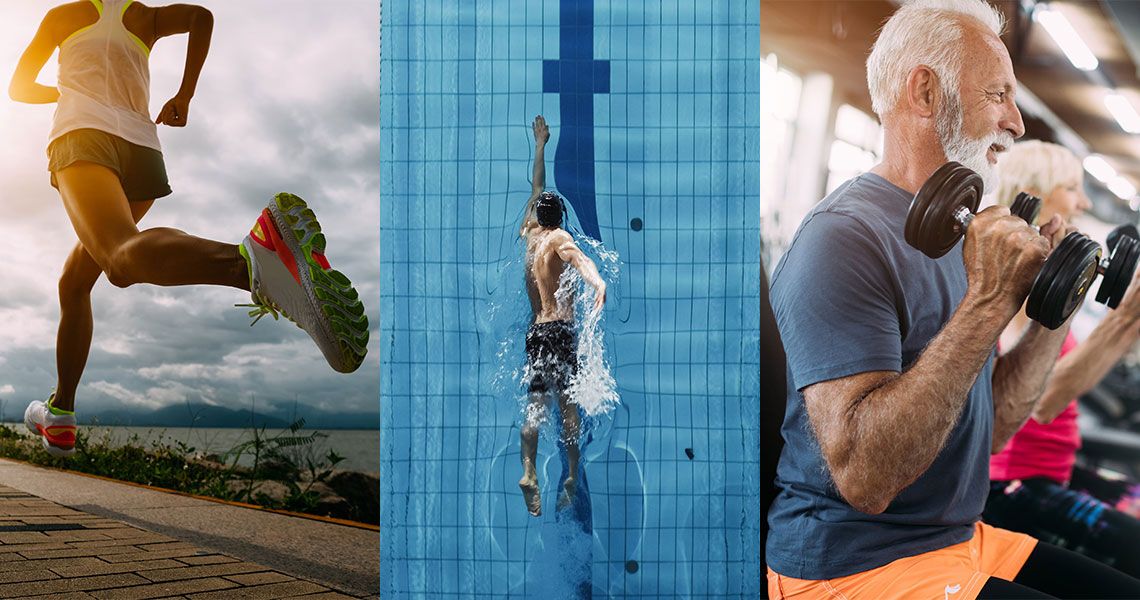
Table of Contents
- Introduction
- Why Should I Care: Benefits of Physical Activity
- Physical Activity Guidelines
- Am I Physically Fit: How to Assess Physical Fitness
- How To Get Started
- Setting Physical Activity Goals
- How to Choose and Work With a Personal Trainer
- Learn About Different Ways to be Physically Active. Get Inspired!
Introduction
Our bodies are meant to move. It is obvious to most that moving our muscles and our bodies is needed for everything we do in the external world but what many people fail to realize is that it is essential for how the internal systems of our body work. The metabolic systems of our body that manage everything from blood sugar to blood pressure to which of our genes are turned off and rely on movement.
"The current human genome requires and expects us to be highly physically active for normal functioning"
Frank W. Booth, PhD
Professor, Nutrition and Exercise Physiology
University of Missouri
Our bodies have not changed much over the past 100,000 years. The hunter-gatherer ancestors of our past spent their days in a near-constant state of motion, searching for food to feed themselves and their tribe. Our bodies are designed to function at peak performance only with that level of activity. Unfortunately in our modern-day lifestyle we spend countless hours sitting down and staring at screens. Our current level of inactivity is one of the key factors that leads directly to our current epidemic of obesity and chronic diseases such as heart disease, diabetes, stroke and mental health problems. The CDC has set guidelines for how much physical activity is needed to maintain normal function and prevent chronic disease. In 2020, only around a quarter of American adults met these guidelines for physical activity and that number decreases with age.
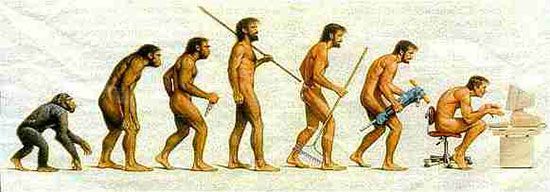
In these pages we will help you think about the many benefits of movement, physical activity and exercise and how to make them part of your life. Each section will provide an overview based on the best scientific evidence currently available and will give you links to dig deeper in areas of interest. Look for hyperlinks that lead directly to articles from the scientific literature. Our goal is to meet you where you are: novice, beginner or advanced and give you tools, ideas and resources to help you move to the next level.
Let’s start by learning more about the differences between movement, physical activity and exercise.
Movement refers to any change in position of the body, while physical activity refers to bodily movements that require energy expenditure Exercise is a structured form of physical activity with the goal of improving and maintaining health and physical fitness. Two key principles:
- You can be healthy even if you don’t like to exercise - as long as you move and are physically active.
- Even if you exercise, if you are sedentary (ie. not moving) your health will suffer.
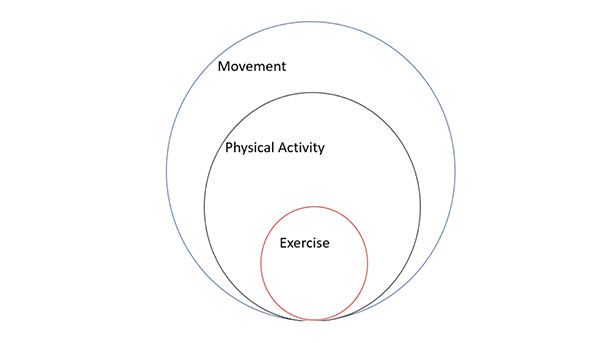
“But it hurts when I move…”
Movement can be one of the joys of life. Unfortunately, one in three adults report some joint pain in the past 30 days and the CDC estimates that one in four Americans will have physician diagnosed joint pain by 2030. The old theory that osteoarthritis was caused by “wear and tear” on the joints has been replaced by the understanding that it is caused by inflammation from an unhealthy diet and sedentary lifestyle. “Use it or lose it” is a better description of what is needed to have healthy joints. Too many of us are sedentary even though we exercise. Experimental data confirm that inflammatory markers rise after only 30 minutes of sitting. Even those who do move regularly tend to repeat the same movements over and over leading to a decreased range of motion of many joints. Strength and flexibility can prevent many of the aches and pains associated with aging. It is important to preserve our ability to get up and down off the ground with ease, move side to side in addition to forward and backward and be able to work with our arms above our head. This requires practice to maintain and in some cases, re-learn. If you have significant pain, you may need to see a Physical Therapist.
Sit Rise Test
The Sit Rise Test is a simple, yet very effective way to warm up AND you can also build it into your workout plan!
What is it:
There is research that the ability to get on and off the floor without the use of your hands is an indicator of mortality. There have been several studies. In one, a team of Brazilian researchers published a study in the European Journal of Cardiology proved this test to be a predictor of how long you will live – or more doggedly put – won’t. The reason we love it is because improvements can be seen in a mere few weeks and no equipment other than your body is needed! I think of it this way: you can boast to your friends and family who will be blown away with your strength and flexibility AND how you've added years to your life!
The benefits are numerous:
- Strength
- Mobility
- Flexibility
- Coordination
- Awareness of our whole body
- Gets you on the floor, where your body knows where it is in space and can more easily sense where it is in space.
- Builds confidence
- Can predict a longer life
What can it do for you:
- Easier to get up if you fall
- Easier to pick things up off the floor
- Make getting on and off the floor or lower seating areas easier
In the study, 2002 men and women ages 51 to 80 were followed for an average of 6.3 years. Those who needed to use both hands and knees to get up and down (whether they were middle aged or elderly) were almost seven times more likely to die within six years than those who could spring up and down without support. Their musculoskeletal fitness, as indicated by this test, was lacking.
“It is well known that aerobic fitness is strongly related to survival,” study author Claudio Gil Soares de Araujo, Professor at Gama Filho University in Rio de Janeiro. He continues, “but our study also shows that maintaining high levels of body flexibility, muscle strength, and coordination also has a favorable influence on life expectancy.
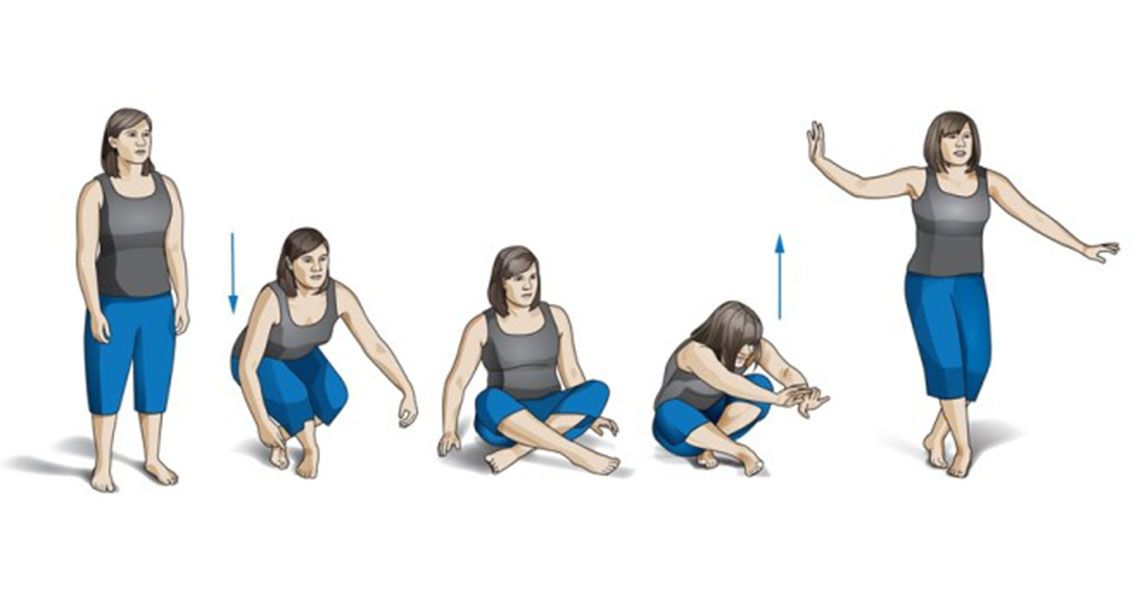
How to do it:
- Go ahead and use two hands at first to stand up. Always aim for safety first. Or, you can even use the help of a step, a couch, a stretch strap tied securely around to help you get up. Then, progress to using just one hand. Once you gain the ability to sit and stand without the use of your hands, the possibilities are endless: hip mobility, leg and core strength, and the freedom of knowing you are independent.
You can start holding onto something secure to the floor or a wall, like a couch, a wall or a counter. We have often seen patients hold only a broomstick placed securely into a corner of a room! - Slowly lower yourself to the floor however it feels most secure, on one knee, placing one or both hands onto the floor or allowing only your bottom to rest on the floor first.
The more you practice, the more prepared your body will be to adapt and do it right. If you are able, attempt to do this in the "criss cross applesauce" position. It not only serves as a great hip opener, it utilizes muscles and everything that connects them together like they haven't done since you were on the preschool floor! - Use one or two hands to get back up. There are a variety of ways to do this. A) One is to place your hands on the floor and get yourself into the "crawl" or "all fours" position. From there you can "stand" in a tall kneel (knees still resting on the floor) and use the help of another object with or without your hands to stand up. B) Another way is to step backward and slowly lower your knee to the floor. Then bring the other knee to the floor. Try to slowly lower your bottom to the floor. The bottom on the floor is the "middle" of the movement with the start AND finish being the standing position.
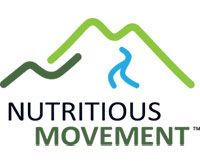
Visit the website Nutritious Movement and learn from Katy Bowman how to move more without exercise. She will show you how to increase movement in your daily life and how to create a movement rich environment.
RETHINK YOUR POSITION • Katy Bowman on The Art of Living Episode 106
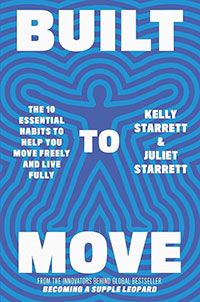
Book Recommendation:
Built to Move by Kelly and Juliet Starrett
10 tests + 10 physical practices = 10 ways to make your body work better. Organized around practices that anyone can do, Built to Move is designed to improve the way your body feels (Less stiffness! Fewer aches and pain!) and boost the overall quality of your life, no matter how you spend your time.
- Easy mobilization practices to increase range of motion and avoid injury
- Intuitive ways to integrate more movement into your daily life and escape sedentary habits
Physical Activity vs. Exercise
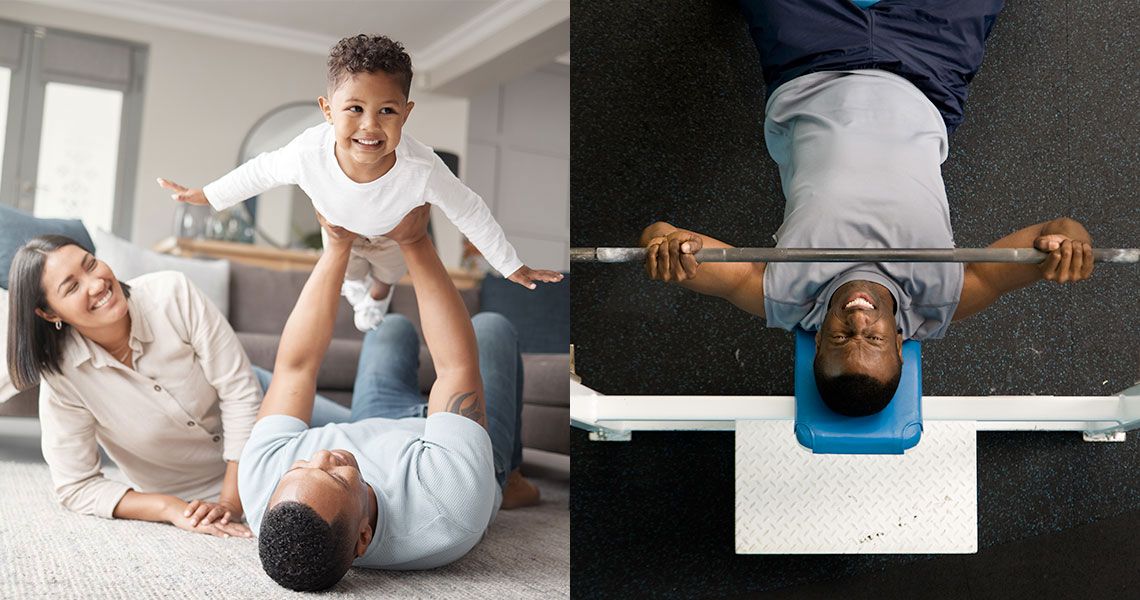
What is the difference between exercise and physical activity? All exercise is physical activity, but not all physical activity is exercise.
Physical activity is simply any bodily movement produced by skeletal muscle that requires energy expenditure in the form of calories burned. This includes anything from lifting weights to taking the trash out. Exercise is a subset of physical activity that is considered to be planned, structured, and purposeful relating to an overarching goal of improvement.
To break this down even further, physical fitness is a set of health or skill related attributes that contribute to overall wellness. There are five components to physical fitness:
- Strength
- Endurance
- Balance
- Flexibility
- Body Composition
To improve physical fitness, you must exercise regularly and progressively increase the intensity and/or duration of the exercises being performed.
Importance of Physical Activity
Physical activity is often the first lifestyle factor you will hear about from healthcare providers when discussing ways to prevent disease, manage chronic conditions, and improve overall health. Does it matter how you move to reap the benefits? The short answer is any activity, even small bursts throughout the day, can help improve blood sugar and improve cardiorespiratory fitness.
Exercise "Snacks" For Nonexercisers
These "Snacks" are something you DO not something you eat. Research published in Nature Medicine shows that as few as 2-3 short bouts of vigorous intermittent lifestyle activity (VILPA) were associated with 40-50% lower all cause, cardiovascular and cancer mortality. Activities like running across the street or climbing stairs lasting only 3-4 minutes a day can provide this benefit. Including regular bursts of high-intensity, heart rate raising movement into your daily routine will boost your everyday health. So take the stairs, carry your groceries and run after your dog to improve your health!
Why Should I Care: Benefits of Physical Activity
Benefits of Physical Activity
Physical activity is arguably the best preventative medicine available to human beings. Living a physically active lifestyle can help individuals maintain a healthy body weight, delay or prevent chronic disease and reduce morbidity and mortality.
Why Exercise is important
Some say movement is medicine. In fact, Dr. Peter Attia, a pioneer in longevity science says “exercise is the most potent “drug” we have for extending the quality and perhaps quantity of our years of life.” Exercise creates a cascading effect. When we exercise, we make better lifestyle choices about our food, we prioritize our sleep, and we even experience anxiety and stress less. In sum, exercise saves lives. When we prioritize overall health and wellness, exercise is the first consideration. When we exercise we are doing not only our bodies, including our brain, a big favor - a big THANK YOU!
It is easy to get stuck in the belief that exercise is only useful when it is in a gym, when it is a 30 minute or longer workout, and when it is strenuous. On the contrary, there are many benefits to exercising throughout the day including:
- Weight loss and maintenance
- General health and longevity
- Joint mobility
- Increased core strength
- Mood regulation
- Enhanced productivity
- Improved heart health
- Better brain health
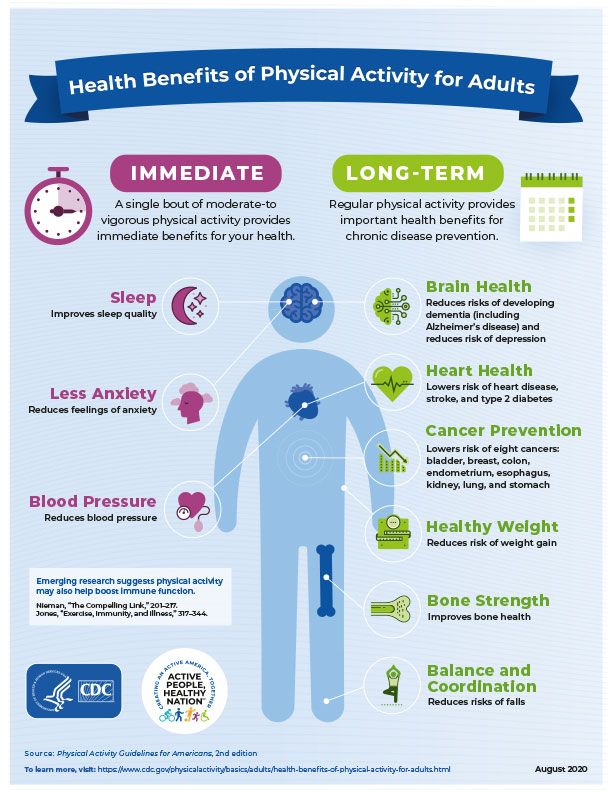
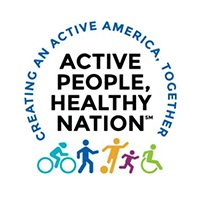
Image via CDC
Graphics: Physical Activity Health Benefits (CDC)
Health Benefits of Physical Activity for Adults
Health Benefits of Physical Activity for Adults 65 and Older
- Benefits of Physical Activity, Continued
-
- Physical activity is shown to be strongly related to life satisfaction and happiness in young, middle-aged, and older adults.
- Its benefits stand independent of weight loss beginning at the cellular level with alterations in telomere length, improvement in anti-oxidative and anti-thrombotic enzymes associated with HDL cholesterol and microvascular enzymes in skeletal muscle that affect capillary density and vasoreactivity which impacts CAD risk.
- Cardiovascular disease (CVD) is among the leading causes of morbidity globally making prevention critical. Physical activity (at least 150 minutes of moderate-to-vigorous level of activity weekly) is associated with decreased mortality and improved quality of life. This is achieved through improving cardiometabolic risk factors.
- Physical activity supports optimal adolescent brain development and performance AND preserves and improves cognition as we age; especially executive functioning and memory in mild cognitive decline, and psychological health in dementia.
- Aids in preventing depression as we age.
- Reduces pain and fatigue, and improve mental health in autoimmune disorders such as rheumatoid arthritis.
- Improves overall physical and psychosocial functioning in children with developmental disabilities.
- Health benefits of regular moderate-to-vigorous Physical Activity
-
Outcomes with moderate to strong evidence of effect as highlighted in these guidelines:
- Lower risk of all-cause mortality
- Lower risk of CV disease morbidity and mortality
- Lower risk of HTN, T2DM, HLD, and numerous cancers
- Improved cognition and reduced risk of dementia
- Reduced anxiety and depression
- Improved sleep
- Improved bone health
- Lower risk of falls and fall-related injuries
- Improved functionality and quality of life
Research suggests that regular exercise generates a boost to the body’s immune system. Some of the conclusions drawn from this study include but are not limited to:
- A bout of acute exercise, meaning exercise of moderate-to-vigorous intensity for less than 60 minutes, improves the anti-pathogen activity of certain cell types and enhances the presence of antibodies and various anti-inflammatory proteins. With daily exercise, these acute changes seen with each bout of exercise become summative and contribute to optimizing an individual’s immune system and metabolism.
- Epidemiologic studies consistently report decreased levels of inflammatory markers in adults with higher levels of physical fitness and activity, even when controlling for potential confounding variables such as BMI.
- Data from randomized controlled trials and epidemiologic studies indicate a clear inverse relationship between moderate exercise and risk of/morbidity from illness, including upper respiratory tract infections.
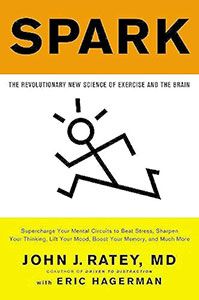
Book Recommendation:
Spark: The Revolutionary New Science of Exercise and the Brain by John J. Ratey MD (Author), Eric Hagerman
A groundbreaking and fascinating investigation into the transformative effects of exercise on the brain, from the bestselling author and renowned psychiatrist John J. Ratey, MD.
Did you know you can beat stress, lift your mood, fight memory loss, sharpen your intellect, and function better than ever simply by elevating your heart rate and breaking a sweat? The evidence is incontrovertible: Aerobic exercise physically remodels our brains for peak performance.
Physical Activity Guidelines: What are they and how are we doing?
Previous Section Next Section Page Top
The current recommendations for Physical Activity set by the Department of Health and Human Services include:
- 150-300 minutes/week of moderate intensity exercise (ex. Brisk walking) OR
- 75-150 minutes/week of vigorous intensity exercise (ex. Jogging or running)
- Muscle strengthening activities on 2 days/week working all major muscle groups (legs, hips, back, abdomen, shoulders, chest, arms)
- Older adults are recommended to incorporate balance training along with aerobic and muscle-strengthening activities
- More health benefits are gained when exceeding the general guidelines
Recommended Levels for Health Benefits
Source: U.S. Department of Health & Human Services
|
Example 1 |
Example 2 |
Example 3 |
|
Moderate-intensity aerobic activity (such as brisk walking) for 150 minutes every week (for example, 30 minutes a day, 5 days a week) AND
Muscle-strengthening activities on 2 or more days a week that work all major muscle groups (legs, hips, back, abdomen, chest, shoulders, and arms). |
Vigorous-intensity aerobic activity (such as jogging or running) for 75 minutes (1 hour and 15 minutes) every week AND
Muscle-strengthening activities on 2 or more days a week that work all major muscle groups (legs, hips, back, abdomen, chest, shoulders, and arms). |
An equivalent mix of moderate- and vigorous-intensity aerobic activity on 2 or more days a week
AND
Muscle-strengthening activities on 2 or more days a week that work all major muscle groups (legs, hips, back, abdomen, chest, shoulders, and arms). |
Read: Physical Activity Guidelines for Americans, 2nd Edition
- How Are We Doing Meeting the Guidelines?
-
According to the CDC, in 2020 only 24.2% of adults age 18 and over met the guidelines for aerobic and muscle-strengthening activities. The percentage of adults meeting these guidelines decreases with age, which is when being physically active should become an even bigger priority. There were also significant differences when accounting for race, gender, and income.
- In 2020, 28.3% of adult men met both the aerobic and muscle-strengthening guidelines compared to 20.4% of adult women
- Non-Hispanic White Men had the highest percentage meeting the guidelines with 30.5%
- Non-Hispanic Black Women had the lowest percentage meeting the guidelines with 16.5%
- For those below the federal poverty line (FPL) 16.2% of men and 9.9% of women met the physical activity guidelines, compared to 32.4% of men and 25.9% of women with an income of 200% of the FPL
Visual Geographic Data: Adults meeting aerobic and muscle strengthening guidelines
Data Tables: Physical Activity Among Adults Aged 18 and Over: United States, 2020
Looking at the statistics, it is clear that Americans are not getting nearly enough physical activity. Why is this the case? There is research showing that it is not necessarily a lack of planned, regular exercise that is causing these trends, but rather a substantial increase in sedentary behavior.
Am I Physically Fit? How to Assess Physical Fitness
Previous Section Next Section Page Top
Physical Fitness Assessment Resources
There are five components to physical fitness: Cardiovascular endurance, strength, balance, flexibility, and body composition.
- Cardiovascular Endurance
-
In scientific terms, cardiovascular endurance is defined as the body’s ability to transport oxygen to the working muscles during sustained exercise. An individual with high endurance will be able to perform moderate-intensity exercise for a long duration before running low on fuel. Cardiovascular endurance is critical for overall heart and lung function and longevity as well as being important in long-duration sports such as cycling, marathon running, and cross-country skiing.
VO2max
This is the greatest amount of oxygen the body’s cells can utilize during exercise, typically achieved near your highest endurance exercise intensity. The V stands for volume, the O2 refers to oxygen, and max refers to maximal exercise. The gold standard for measuring VO2max is done in a laboratory and involves wearing a mask that measures the volume and concentration of oxygen in expired air collected during an endurance exercise test carried out to failure, usually on an exercise bike or treadmill. While this is the most accurate way to measure VO2max, it is costly and requires expensive equipment and trained clinicians to carry out. There are several submaximal exercise tests conducted using an elevated step, treadmill, or bike to estimate VO2max. While these submaximal tests may not be quite as accurate or individualized, they are much more available and accessible to the average person in addition to providing a good indication of their VO2max. Submaximal endurance tests can also be useful in populations with certain health issues where performing maximal exercise is not safe or recommended.
Study: Validity of Submaximal Step Tests to Estimate Maximal Oxygen Uptake in Healthy Adults
Tips for Monitoring Aerobic Exercise Intensity
Resting Heart Rate
In most cases, a lower resting heart rate implies better heart function and cardiovascular fitness. Resting heart rate typically decreases as an adaptation to cardiovascular endurance training. While resting heart rate can be modified with chronic endurance training, maximal heart rate tends to stay consistent regardless of fitness level and is age dependent. Maximal heart rate decreases with age and is most easily estimated by subtracting your age from 220 (Max HR = 220-age).. The best timeframe to measure resting heart rate is just after waking up in the morning while still lying down in bed. Resting heart rate can be measured by using a clock or a stopwatch on your phone, finding your pulse near your wrist, and counting the number of pulses felt in a 15-second period. The number of pulses in 15 seconds is multiplied by 4 to estimate your resting heart rate value in beats per minute (bpm). Using your several common mobile applications, you can use your phone’s camera to measure your resting heart rate. Lastly, there are also a number of wearable devices you can use to measure your heart rate during sleep, your resting heart rate, and/or track changes in your heart rate throughout the day regardless of your activity level.
- Strength
-
Measuring strength is one of the more difficult measures to obtain because it is commonly measured in different areas of the body, for example upper body versus lower body strength. There typically is not a common all-encompassing method for measuring total-body strength. There is also some confusion as to what exactly is being measured when people talk about “strength”. Strength measures the amount of force that your muscles can produce in a given task or action. This is different from measuring muscular power, which is the ability to exert maximal force as quickly as possible when performing a task or action. Strength is also different from muscular hypertrophy, which is the increase in size of a muscle. While an increase in muscle size is typically associated with increased strength, strength is commonly expressed before an increase in size. When measuring muscular strength, it is important to clarify what aspects of muscular strength you intend to measure as well as taking into account the subject's fitness level and experience with different forms of exercise equipment. Common aspects of muscular strength include maximal strength, submaximal strength, and strength endurance. Maximal strength is the greatest amount of resistance the muscles can overcome or move during a movement, activity, or exercise. Submaximal strength uses the same principles, movements, and exercises to estimate maximal muscular strength. On the other hand, strength endurance or muscular endurance is typically described by lower resistance exercises or activities performed for longer periods of time or for larger repetitions. Below are a few methods to measure strength for different regions of the body and experience of the subject being tested.
1-Rep Max
A 1-repetition maximum test involves an individual moving the maximum amount of weight throughout the required range of motion with correct technique for one repetition. This is considered the gold standard for measuring muscular strength and it is commonly used for exercises such as the bench press, leg press, squat, and deadlift. While this is a great method for evaluating resistance-trained individual, it is not the best for those with limited resistance training experience or a history of muscle, skeletal, joint, or tissue injuries due to the greater risk. 1-repetition maximum testing involves a great deal of technique and experience in movement, activity, or exercise being performed to ensure safe and reliable results. Additionally, maximal testing requires a trained professional to be present and spot during the exercise test.
Handgrip Dynamometer
Handgrip strength is a crucial measure of functional strength and has many applications in day-to-day life. It is also a major indicator in the diagnosis of sarcopenia, which is the progressive loss of muscle mass and strength with age. To test handgrip strength with a handgrip dynamometer, the subject holds the instrument parallel to the side of the body with the elbow flexed at 90 degrees. The individual then squeezes the handgrip as hard as possible without holding their breath for five seconds. Repeat the test two more times, taking one minute of rest in between each squeeze. The test is typically performed with each hand, but can also be performed with only the dominant hand. If performing the test with both hands, take the highest value of the three readings for each hand and add these two values together. If only the dominant hand was assessed, use the highest of the three readings for comparison. Measurements are displayed as force in either pounds or kilograms. According to a study from the European Working Group on Sarcopenia in Older People I, the cutoff value for diagnosing sarcopenia was <30kg for men and <20kg for women (Lauretani et al.) This test is easy to administer and can be completed at the GW Plant-Based Lifestyle Medicine Clinic.
Dead-Hang
Similar to the handgrip dynamometer, this is a test of grip strength. However, it does not require any equipment besides a pull up bar, and can easily be completed at home and without any outside assistance. The test requires the subject to grip the bar with both hands and hang with the arms straightened for as long as possible. Ideally, one should be able to hang for at least 30 seconds with over a minute being a strong goal to aim for.
Leg Extension
This is a method for measuring lower-body strength, specifically the quadriceps, that is much easier for those who are not experienced weightlifters. This is an isolation exercise meaning it only targets one muscle group, in this case being the quadriceps. What makes this exercise a quality test of strength is that it does not require much skill or technique, which allows those who are not experienced with squatting or deadlift a good opportunity to measure their lower body strength. According to Dr. Andy Galpin of California State University Fullerton, adults up to age 40 should be able to lift their body weight with a 10% reduction every decade after 40. The main drawbacks to this test are that it only measures the anterior (front) portion of the leg and it can put a great deal of strain on the knee so it is not always recommended for those with prior knee injuries. For those who struggle with this exercise, only performing the last 45 degrees of extension is an easier way to execute this movement as it takes much of the pressure off the knees.
- Balance
-
Balance refers to the ability to maintain posture and return to equilibrium following a disruption that knocks the body over its center of mass. This becomes more important as we get older as it is a critical part of preventing falls.
How can you know your baseline and measurement for success?
Stand with your eyes open, lift up one leg. Hold for 20 seconds. After you have mastered holding one leg up unassisted (not holding another secure object), try this with your eyes closed. It is an "eye opener".
Balance Training
While you may be tempted to stand on a wobbly surface for balance training, it isn't super functional. We believe standing on one foot is a great place to start. After all, many falls occur during walking - when we are ACTUALLY just on one foot. So, let's tell the brain how to get strong in that vulnerable position!
Why Train for Balance?
First, how many times in the next few decades will you stumble on an object on the floor, miss a step up or down or be brushed by accident by another in a crowd? We contend at least a dozen if not more. Balance trains you for this circumstance, giving your brain practice for that very incident and your body's ability to "recover" with strength, not vulnerability. Last, and certainly not least, The World Health Organization (WHO) found that falls are the second leading reason for accidental or unintentional injury deaths worldwide, and that adults aged 65 years and older sustain the majority of fatal falls. Falls among those aged 60 and older are not rare. They can result in traumatic brain injuries, fractures or loss of independence. In many studies, loneliness, social isolation, and living alone were significantly associated with falls in older people.
Maintaining balance as well as strength is critical for preventing falls and other injuries. Balance can be learned / trained. You can talk to your doctor, a physical therapist or try these on your own:
- 12 Balance Exercises for Seniors (handout)
- Beginner Balance Exercise Video
- Intermediate Balance Exercise Video
- Tai Chi and Yoga are also helpful for developing strength and balance
- Flexibility
-
The definition of flexibility is the ability of a joint or group of joints to move freely through its range of motion. The range of motion of our joints is influenced by the soft tissue that surrounds it including the ligaments, tendons, and muscles. A lack of flexibility can have detrimental effects on our overall health by decreasing the flow of blood and nutrients to the joints as well as increasing the risk of injury due to abnormal stress placed on structures away from the inflexible joint. Similar to strength, flexibility varies throughout the body and cannot be measured from one specific test. There are a number of different field tests used to measure flexibility throughout different regions of the body.
Sit-and-Reach
This is perhaps the most commonly used test to measure flexibility and is commonly used in physical education classes throughout the country. This test requires the subject to flex the hip and reach forward to try and touch their toes. It is a useful measure of flexibility in the lower-back and upper-hamstrings.
Shoulder Stretch (Zipper)
This test involves the subject reaching over their shoulder and down the back with one hand and behind the back and upward with the other hand with the goal of touching hands. After completing one side, the test should be repeated with the arms in opposite directions.
Health-Related Fitness Measures for Youth: Flexibility (NIH)
- Body Composition
-
Body composition is the term used to describe the distribution of muscle, fat, and bone within our bodies. This measurement holds a lot of value for aesthetic reasons, but one’s body fat percentage can also tell a great deal about their general health. It is without a doubt beneficial to limit the amount of body fat you are carrying on you. Excess body fat is linked to a myriad of metabolic issues such as diabetes, and hypertension. This is especially true of visceral fat, which is the fat stored deep inside the stomach and wraps around the internal organs. Visceral fat is very metabolically active, but not necessarily in a good way. While subcutaneous fat, the fat right below the skin, produces many beneficial molecules and is often used as an energy reserve, visceral fat produces cytokines leading to inflammation and a host of potential chronic diseases. However, human beings must carry a certain amount of body fat to remain in good health, and examining the distribution of fat to muscle can tell us a great deal about one’s general health and fitness level. There are many different methods used for measuring body composition. New technology has made great improvements to the accuracy of these tests. However, many of these tests can be costly, time consuming, and require the help of trained professionals. This is especially true for some of the more accurate tests for measuring body composition.
BMI
While this does not directly measure body composition, this is the most commonly used method for measuring obesity in the general population. It is measured by weight in kg divided by height in meters squared (kg/m2). Normal BMI ranges should fall between 18-25, with anything over 25 being considered overweight and anything above 30 being classified as obese. This is a commonly used method because it is easy to obtain and there is already extensive data. However, it is far from the best method to use as it does not take into account proportions of fat mass and muscle mass. This can be misleading because someone with a very low body fat percentage, but high amounts of muscle would have a high BMI even though they are not at all obese.
Waist-Circumference
Obesity is typically associated with visceral adiposity, which means fat located in the abdominal area. Adipose tissue in the abdominal region can have serious health implications because it surrounds many of the body’s internal organs. This is especially prevalent in obese males and is what gives the appearance of a large stomach or “gut”. Measuring the circumference of the waist is a common tool for determining obesity, although it is not a perfect indicator. Absolute numbers are not typically used because they do not account for differences in body size and fat distribution. The ratio of waist to hip circumference is the most common measure used to indicate obesity. Typically, men with a ratio greater than 1.0 and women with a ratio greater than 0.85 are at increased risk for chronic disease.
DEXA
This is one of the more popular and accurate methods of obtaining body composition measurements and it is relatively easy and time-efficient. This machine measures bone-density by having the subject pass through a high and low energy x-ray machine. In total, the whole process only takes between 10-20 minutes and exposes the subject to very minimal amounts of radiation. The main drawbacks of this method are that it is expensive and many of the machines cannot accommodate larger individuals.
Bioelectrical Impedance Analysis (BIA)
These devices send electrical currents through the body to measure total body water, fat mass, and fat-free mass. This method is widely used, but there is great variation in the accuracy of these devices with many cheaper options available that lack the validity of more expensive models. BIA machines are widely available and user-friendly, but are not always the most accurate, especially when used on obese subjects.
Skinfold Measurements
This method measures subcutaneous fat thickness throughout various regions of the body using skinfold calipers and is cheap, easy, and reliable. While this method is widely used due to its low cost and ease of use, it is not very reliable for obese subjects as the calipers can often not fit entirely around the amount of skin on these larger individuals.
Study: Body Composition Methods: Comparisons and Interpretations
If you are in the Washington, D.C. metropolitan area and are interested in getting a comprehensive body composition measurement, the George Washington University Metabolism and Exercise Testing Laboratory has what you need. Open to the public, this laboratory offers multiple methods for measuring body composition and resting metabolic rate. For those interested in gauging their exercise performance, the lab offers exercise testing for VO2max, ventilatory/lactate threshold, and functional movement screens. This is a fantastic resource for anyone interested in beginning an exercise program and for those who want to track their progress.
George Washington University Metabolism and Exercise Testing Laboratory
Open to the public, this laboratory offers multiple methods for measuring body composition and resting metabolic rate. For those interested in gauging their exercise performance, the lab offers exercise testing for VO2max, ventilatory/lactate threshold, and functional movement screens. This is a fantastic resource for anyone interested in beginning an exercise program and for those who want to track their progress.
Explore the GW Metabolism and Exercise Testing Laboratory Website
How to Get Started
Previous Section Next Section Page Top
Is it safe for me to start an exercise program?
While exercise is a fantastic tool to prevent and treat chronic diseases, there are certain things to consider before starting an exercise program. The Physical Activity Readiness Questionnaire [PAR-Q] is a health screening typically given by doctors and personal trainers to determine if an individual is ready to start an exercise program, and if they are, what intensity are they ready to exercise at? This questionnaire is a great resource for identifying health issues which could become problematic during vigorous exercise. Exercise increases one’s heart rate, which can be extremely dangerous for those with certain heart conditions and needs to be monitored closely when beginning an exercise program.
To find out if it is safe for you to begin exercising, take the online Physical Activity Readiness Questionnaire (PAR-Q).
When do I need to see a Physical Therapist?
Physical Therapists are health care providers who are considered the experts of musculoskeletal and neuro-musculoskeletal disorders and dysfunctions. They are an integral part of the health care system when it comes to helping treat individuals that have experienced an injury, as well as to even help teach individuals how to reduce their risk of injury. Just like any health care provider, Physical therapists have the ability to specialize in one or more of the ten advanced specializations that are acknowledged by the American Board of Physical Therapy Specialist as well as the American Physical Therapy Association. The ten specialties that have been designated by the Board are: Orthopedics, Sports, Geriatrics, Neurology, Women’s Health/Pelvic Health, Pediatrics, Oncology, Electrophysiology, Oncology, Wound Care Management, and Cardiovascular/Pulmonary specialist. Within each specialization Physical Therapist have the capability to address any deficit or dysfunction an individual can present with.
Physical activity is recommended for all ages by the CDC, and is so important to help us stay strong and healthy. But sometimes injury can occur from increased activity, should that be from overuse or performing exercises incorrectly. So that poses the questions of when does one know that it is time for them to see a Physical Therapist? Well the answer to that question is really, anytime! While you can see a Physical Therapist at any point, here are a few times when PT should be your first stop prior to returning back to your typical routine based on your injury or condition.
- See an Ortho/Sports PT at any point when joint or muscle pain/symptoms take longer than three days to resolve, or you have noticed a loss of motion or strength. Individuals should also consider seeing a PT when their chronic or recurrent pain impacts their daily activities or limits their ability to participate in physical activity, when medication hasn’t worked, or even prior and post-surgery.
- See a Pelvic Health/Women’s Health therapist at any point you are experiencing pain with sex, pelvic pain, bowel/bladder deficits, perinatal/postpartum, or if you are experiencing testicular pain.
- See a Neurologic PT if you have been diagnosed with a progressive neurologic disease, are an amputee with recent decrease in function, or even if you are experiencing increased falls as it relates to a concussion or a vestibular condition.
- Concussion as it relates to return to sport can also be treated by an orthopedic/Sports PT that has advance training in treating concussion and vestibular conditions.
While this list just mentions a few of the reasons why an individual can see a Physical Therapist. The ultimate goal anytime you see a Physical Therapist is to assist with restoring you back to your prior level of function, or your new level of function, all while helping you learn how to live and maintain a healthy lifestyle. So as mentioned previously, there really isn’t a right time to see a Physical Therapist, as PT’s are always available to meet you where you are in your journey to get and maintain physically active.
Polo Edwards PT, DPT, OCS, Cert. MDT
The George Washington Outpatient Rehabilitation Center
Beginning an Exercise Program
We aim to meet you where you are. We are here to help you feel a level of confidence in your movement and ultimately with your body you've possibly never felt - or it's been a long time!
Set Up Your Environment for Success
Now that you've not only made the decision, yet also committed to beginning an exercise program, it is time to be selfish: find your space. make sure to set aside a location in this space that is "your space" to exercise. For example, if a little section of my bedroom is where I exercise, I will keep a towel or yoga mat on the floor to remind me throughout the day to "return to it". I may keep a few items like a bag of sugar (five pounds!) or a small set of inexpensive dumbbells eventually. Yet most important is the space you set aside - for YOU! Make sure to place a "cushion" like a towel in that space that ideally stays there in your "home gym"!
As always, progress first with safety and pay close attention to your body. Begin to learn the difference, for you, between "pain" and "discomfort". You may feel a little "sore" the next few days. Soreness in your muscles and even your joints is actually not a bad thing. It can be an indicator you are working areas of your body in a way they need to be challenged. Don't allow soreness to slow you down. If you need an additional day of rest, take it, yet understand that movement often helps that soreness work itself out and fosters recovery.
If you are home, you can feel free to complete this program barefoot. Our feet like to feel where we are and use the floor for our movement. As long as you are in a safe space and not concerned you will harm your feet, go barefoot! This will also work your feet too!
Last, the first few times will take longer because you will be completing these exercises for the first time. Getting set up, making sure you feel good while performing can take time. Yet, once you learn them two to three times, it will take less time because you won’t be reading instructions and everything that goes into learning something new.
Timing
Start small. The science of habit teaches us that new habits not only start, yet continue, when we feel like they are important to you, be small, simple and easy, and repeatable. We also know that willpower and discipline do not work in the long run. Habits do.
From studies on habits, we also know that cues or triggers help tremendously. The most common cue or trigger is location and time. So finding a time of day and a location for your exercise will help set you up for success. March with knee coming up as high as your hips.
- Beginner Exercise Routine
-
1. Get on the Floor
Use one or two hands and anything (furniture, a wall, etc.) to get there. . Lay down face up. Use your hands to hold your knees or your feet, if possible. Breathe deeply 5 times. Repeat 5 times. This is meant to stretch your back in the easiest way possible.
2. Soft Roll
Face up on the floor with your arms stretched wide forming a "T". Lift your left leg bringing your left knee to your chest (without using your hands if possible). Slowly bring your left knee toward the floor on the right side of your body while keeping your left shoulder pressed gently to the floor and your head looking at your left shoulder. Breathe deeply 5 times. Repeat on the right side.
Video: Intro to Rolls and Soft Roll
3. All Fours Position
Turn over and get in the all fours position placing hands beneath shoulders and knees beneath hips. Rock your hips back and forth - hips shifting BACK toward feet and then returning to the start position. Repeat 10 times with deep breaths for each shift.
4. Walk Around Your Space
Walk around your space swinging your arms for one minute. Try to swing your left arm forward when your right foot is forward, also called “opposing limb” walking. This is how we were meant to walk!
Once you can easily complete any of the movements, progress to the following. When #1 feels comfortable, go ahead and skip to the Intermediate version below of #1. The same applies to #s 2, #3, and #4.
1. Get on the Floor Progression
Get on the floor and lay down face up, placing your feet flat on the floor with your knees at a right angle (bent so it feels comfortable to keep your knees up) and about 20 inches apart,or just outside where your hips hit the floor.
- Place your arms by your side keeping them straight and with your palms facing down into the floor.
- Take a deep breath inward with your mouth closed and slowly and gently lift one leg at a time where your knees are above your hips.
- When the knees are up, slowly exhale as you slowly lower your legs, one-at-a-time at first then progressing to both right and left simultaneously. Use your hands and arms for any help you need. Repeat 10 times.
*Pay attention to how much you back “opens up” with each movement. When we lift our knees into this position, our backs naturally press toward the floor. It is a great way to stretch that low back! You can use this stretch any time to stretch out a tired back at the end of the day or between meetings. - Once you are comfortable with this movement - slowly allowing the legs to fall to the floor, work to LIFT both feet off of the floor simultaneously. Use the same breathing. (A deep inhale is a nice way to protect your back.)
- When we “widen the angle” or straighten the legs more and more, the challenge gets greater.
- When we lift our heads off the floor looking through our legs, that is the ultimate challenge. The human head weighs fifteen pounds so it adds a level of challenge to any floor and core movement.
- Make sure to comfortably be able to complete ten repetitions before you progress to the next level.
2. Soft Roll Progression
From the Soft Roll, progress to straightening the working leg until the hips take the belly to the floor. Not only does this movement work our core, it opens up our back which is likely tight as a result of excessive sitting.
See the Intro to Rolls and Soft Roll Video
3. All Rolls Progression: Get Ready to Plank!
- We are all mostly familiar with the plank. Yet did you know they are often completed incorrectly and are even made more challenging than they need to be! From today forward, think about planking while you are standing, sitting, kneeling and here in the all-fours position.
- After you have mastered the rocking from the Beginner section, now you can “plank” in the all-fours position!
- Open up wrists first. Stretching and opening up the wrists is important here so we can use our joints in their full range of motion and how they were intended. Wrists are another joint that is overused (computers, phones, driving) and not tended to. See video Wrist Prep and Strengtheners.
- Cat Crawl - See video Cat Crawl for technique.
- Placing your hands directly beneath your shoulder and elbows and your knees directly below your hips, press your hands into the floor and “straighten” your back so your belly isn’t dipping toward the floor and the top of the back isn’t “slouched”. Keep it straight.
- From here begin to lift “opposing limbs”) left hand and right knee/right hand with left knee four to six steps forward. The goal is to keep the hips and back from “swaying” side to side. This is the plank! Repeat three to five times.
- After you complete each round, shake out your wrists.
- After you have mastered the crawl with your knees on the floor, you can start to crawl (opposing limb style is essential) four to six steps at a time taking breaks to shake out your wrists.
- Spend ten to twelve sessions solely moving forward before you consider adding steps and/or crawling backward.
4. Walk Around Your Space Progression
You can progress your walk around your space in a variety of ways:
- Walk backward - yes still opposing limb
- Walk sideways (laterally) - pay attention to how you foot hits the ground
- March with knee coming up as high as your hips
- Walk fast while waving your arms quickly
- Take steps (forward and or/sideway)
- Jog slowly around your space
- Advanced Beginner Program
-
Progressing from Beginner, taking time to master Intermediate movements is essential to safety and success. Success means you are getting cardiovascular exercise AND strength training all in one. Success means you feel great doing the exercises and they make you feel confident in how you perform them!
1. Hollow Hold
Take note in the video how you have already mastered the beginning, and the set up of the Hollow Hold. Hollow holds are a staple in most strength training athlete’s programs and now they will be for you!
2. Open Close Roll
No better way to open up our tight back, get us on the floor AND work our core. This is one of the most efficient exercises out there! It is not easy, so take your time!
3. Bear Crawl
4. Walk
Walking is a great way to amp up your heart rate and to recover. Use this time of the workout to congratulate yourself and give your body what it needs most. If it is ready for a little challenge, practice one of the forms of walking listed above yet focus on your breathing. Breathe into and out of your nose as much as possible.
- Intermediate Bodyweight Program
-
- 10 Bodyweight squats
- Fundamentals of the Squat
- 5 push-ups
- Video: Push-up without CTA
- 10 Rows
- 10 Open Close rolls
- Repeat 3-6 times
- 10 Bodyweight squats
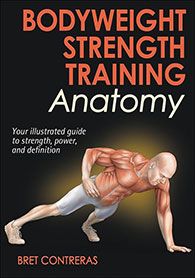
Book Recommendation:
Bodyweight Strength Training Anatomy by Bret Contreras
Increase strength, build mass, burn fat, and define your muscles. With full-color anatomical illustrations, step-by-step instructions, and training advice, Bodyweight Strength Training Anatomy is the authoritative resource for sculpting your physique without free weights, machines, or expensive equipment.
Let your body be the gym with Bodyweight Strength Training Anatomy
Setting Physical Activity Goals
Previous Section Next Section Page Top
1. General goals to strive for per CDC and Physical Activity Guidelines for Americans
Recommendations: Adults should get at least 150 minutes of moderate-intensity aerobic physical activity or 75 minutes of vigorous-intensity physical activity, or an equivalent combination each week. Children and adolescents should be active for at least 60 minutes every day. Following these guidelines can contribute to overall health, and decrease the risk of chronic diseases such as heart disease, cancer or diabetes.
CDC: Benefits of Physical Activity
Health.gov: Physical Activity Guidelines Advisory Committee Scientific Report
2. Goal Setting and Achieving
Huberman Lab: 10-Step Approach to Designing a Training Program
Set goals that are SMART (specific, measurable, attainable, realistic, timely).
Maintaining structure and adherence are critical for achieving goals. Write down an initial plan and update it regularly (i.e. as weight/repetition increases, as new exercises are implemented into routine) to track progress. Use the workout logs and schedule that you have written down to better adhere to your routine and reference these notes to identify where you are currently at in your progression towards your goal.
A goal should feel a little scary. If a goal is perceived as being too easy, you are likely to walk away early because you’ll realize that you can accomplish the goal without much effort. If a goal is perceived as being too hard, you are also likely to quit early because achieving the goal will seem like an impossible task during the initial stages of working towards the goal. Having a goal that is challenging but attainable will help you improve yourself and will keep you accountable, as the only way to achieve this goal is to keep showing up and putting in the necessary work.
**Information above is adapted from the video Dr. Andy Galpin: Optimize Your Training Program for Fitness & Longevity | Huberman Lab Guest Series
How to Choose and Work With a Personal Trainer
Previous Section Next Section Page Top
What does a Personal Trainer do and what are the benefits of working with one?
When deciding to engage in more physical activity and exercise, many people seek out the services of a personal trainer. Personal trainers are accredited, certified fitness professionals who have received training in exercise technique and program design. A personal trainer’s job is to help guide clients towards achieving their exercise and fitness goals by providing the knowledge, support, and accountability necessary to attain them. While not everyone may choose to work with a personal trainer, there are a number of benefits to doing so. Personal trainers can design and manage effective exercise programs for their clients, this is useful for those who don’t have the fitness expertise to do so, or who don’t have the time or desire to plan, track, and manage their regimen themselves. Personal trainers can also serve as a source of support and accountability for their clients. Some individuals find it easier to make it the gym or follow a workout routine if they know a trainer is waiting on them, or will hold them accountable if they skip a workout. Trainers can also support their clients during a workout, providing positive feedback and pushing or encouraging them to work harder than they might on their own. Trainers can also help clients avoid injury by teaching them proper technique and equipment usage, monitoring their form during exercise, and helping them avoid overtraining. It is important to remember that trainers’ area of expertise is generally limited to exercise. Though some trainers may have additional knowledge regarding nutrition and injury rehabilitation, unless they have received formal training and accreditation in these areas, a good trainer will refer you to another specialist with greater expertise.
Where to find a Personal Trainer
The following is a list of resources or places to look to help you find a personal trainer.
- Your personal gym or local rec center: Many gyms and rec centers have in-house or on-site personal trainers available to work with their members.
- Ask friends and community members who have worked with trainers before or are regular gym-goers.
- Look on websites like Yelp or neighborhood listservs for local trainers, or websites such as fitnesstrainer.com.
- Check out online training portals such as Trainerize to see if there are any local trainers on the platform.
How to choose a Personal Trainer
One of the most important factors in achieving success with a personal trainer is ensuring a good fit between the trainer and client. Communication between the trainer and the client is a huge determining factor for achiving the client’s goals. As a result, selecting a trainer who suits your personality, goals, and needs is important. Below you will find a list of tips and things to consider that can help you in selecting the right trainer.
1: Verify that they are certified by a well-respected and accredited certification program.
Such programs include NASM or ISSA, that require a several month course of study for the initial certification and follow-up continuing education courses to maintain the certification.
You can validate credentials on these sites:
There are no federal regulations establishing who may or may not call themselves a personal trainer. As a result, there are some individuals working as trainers who have not received formal training from one of the many professional and accredited certification programs. These certification programs establish a baseline level of quality, professionalism, and expertise, ensuring that those certified have the necessary knowledge to help clients achieve their goals. While many gyms require their trainers to be certified, this is not always the case and so it is worth asking a potential trainer if they’re certified and where they received their certification from. If a trainer isn’t certified, they may lack the appropriate scientific knowledge to guide you towards your goals and may instead be relying on their own personal experience or beliefs.
2: Make sure their training style/specialty suits your goals and needs.
While certified trainers have a general knowledge regarding exercise and program design, trainers also have their own specific areas of expertise or preferred training methods. You want to ensure that your trainer’s expertise aligns with your goals. For example, if you are training for a marathon or triathlon you want to work with a trainer who has knowledge in those areas rather than one who specializes in crossfit or bodybuilding. While a bodybuilding expert may still be able to guide you towards your goals, they may have limited experience with that style of exercise and you’d likely be better off working with someone whose specialty fits your goals. When meeting a potential trainer, it’s okay to ask them about their areas of specialty and what experience they have working with clients who share your goals.
3: Ask for testimonials or to speak to current and previous clients.
A well-established professional trainer will likely already have client testimonials on hand, on social media, posted at their gym, or on their website. It is worthwhile to look through those testimonials and see how their clients describe their experiences working with the trainer. You may also find it valuable to ask the trainer if you can personally speak to one of their clients, as this can give you deeper insight into what it might be like to work with them beyond what is offered in the testimonials. If possible, you may want to speak with both current and previous clients as the previous clients may feel more comfortable giving you an honest opinion of what it was like to work with the trainer. Don’t worry about potentially offending the trainer by asking for these references as a good trainer should have these references on hand and has likely been asked to provide them before. You should also take note of whether the trainer checks in with their client before putting you in touch with them, while some clients give their trainers standing permission to use them as referrals, this is not always the case. Their willingness to provide you with their clients’ contact information without checking with the client beforehand speaks to their professionalism and respect for their client’s privacy.
4: Ask for a trial session.
Oftentimes, the best way to determine whether or not a trainer is a good fit for you and your goals is to actually go through a session with them. Many gyms and trainers will offer a complementary first session, and it is important to take advantage of that session to see what the experience is like. If the gym or the trainer doesn’t offer you a trial session for free, it may still be worthwhile to pay for a single session before making a larger commitment.
Listed below are some questions you should ask yourself during the trial session to help you decide whether they are a good fit.
- Do they listen to your goals and needs and ask questions?
-
A good trainer will not only listen to what your goals are but will try to understand why you set those goals and what is motivating you. Observe whether they take the time to really listen to what you are telling them and are able to reflect it back to you. If they ignore you, or listen without trying to understand it may suggest that they are not invested in your needs or goals or are not taking an individualized approach to each of their clients.
- Are they attentive?
-
During a session a good trainer will keep the client as their primary focus. This is crucial in order to monitor the client’s form, workout intensity, and prevent injury. A good trainer will not only visually monitor their client, but will check in verbally on how their client is feeling and what they are thinking. If a trainer is checking their phone, talking about themselves or to others, or generally not paying attention during your workout it suggests that they are not fully invested in meeting your goals and that you should seek assistance elsewhere.
- Are they able to explain your routine and answer any questions in a way that is easy for you to understand?
-
A good trainer should be able to explain the purpose behind each aspect of your exercise routine and why they selected it in a way that reassures you and helps you build independence as a client. They should also be able to break down the dynamics and techniques of specific exercises or answer general questions about your training regimen. They should also feel comfortable telling you when a question is outside their area of expertise and be able to refer you to a specialist or other resource that can better answer your questions. If a trainer is upset by your asking questions, or is unable to provide adequate answers it may be a sign that they aren’t a good fit.
- Are they receptive to feedback?
-
While trainers may have greater expertise in exercise and fitness, they are not inside your body and don’t know what you are experiencing during and after exercise. As a result, a good trainer relies on, and often seeks out, their clients’ feedback throughout the session. If you tell them that an exercise is too difficult, too easy, or doesn’t feel right, see how they respond. A good trainer will hear you, probe for further clarifications, make adjustments as necessary, and be able to explain any adjustments or lack thereof. If the trainer isn’t receptive to your feedback, or writes you off, it suggests they are not taking an individualized approach to your training and are likely not a good fit for your needs.
- Does their style of motivation suit your needs?
-
Everyone has a different style of motivation when it comes to working out. Some people prefer gentle encouragement while others work better with a drill-sergeant-like approach. A good trainer will adapt their approach to motivation based on their clients needs and preferences. Feel free to tell your trainer how you like to be motivated prior to the start of your session. Maintaining motivation throughout the workout is key to creating adaptive challenges and helping you achieve more than you would working out alone. If you don’t find a trainer motivating, or their motivation style makes you uncomfortable, they may not be a good fit.
- Do they hold you accountable and manage your intensity?
-
A good trainer will hold you accountable in and outside of them gym in order to ensure you are putting in the necessary time and consistency to achieve your goals. That being said, a good trainer will also strike a balance in moderating your intensity. They should push you within your limits and set challenging goals that are reasonably beyond what you might attempt on your own. At the same time, a good trainer will listen when you tell them you are low on energy or concerned about getting hurt, and adjust their plan accordingly. An experienced trainer will balance listening to your feedback and making adjustments without “letting you off the hook”. Many people will try to bargain or talk down the intensity of an exercise or workout they mentally don’t want to do but are physically capable of. An experienced trainer should be able to tell the difference. If you find that you are constantly able to talk your way out of an exercise you are physically capable of but don’t want to do, it is a sign that the trainer isn’t appropriately challenging you. While during a given session it may feel good to get a reprieve, it may be a sign that the trainer won’t adequately progress your routine over the long-term in order to meet your goals.
- Are they accessible?
-
A good trainer is accessible to their clients with respect to time/scheduling, location, finances, and supporting their clients’ independence. You should evaluate how accessible a trainer is in each of these regards when determining whether they are a good fit.
Client Independence
Part of a trainer’s job is guiding their clients towards a healthier lifestyle, independent of their time spent with the trainer. As a result, a good trainer will work towards you becoming less reliant on them over time. This often involves communicating with clients outside of the time during sessions. This could include checking in with a client the day after a tough workout to assess how they are recovering, or answering questions a client has when the client is working out on their own. While trainers have to balance communicating with other clients and their own personal lives, if a trainer is largely uncommunicative outside the scheduled time of a session they may be hindering your growth towards independence.
Scheduling
Does their schedule match yours? Even if a trainer is a perfect fit in all other respects, you will only have success if you are actually able to meet with them. Consistency is key in meeting your exercise goals and maintaining a healthy lifestyle. If a trainer’s schedule is a poor fit for yours, or you have to make huge adjustments to your schedule to meet theirs, they are not a good fit. If you find yourself constantly having to cancel or show up late to sessions because of other priorities or commitments, you are wasting your time, money, and effort and would likely benefit more from working with a trainer who better fits your schedule.
Location
Is the trainer easy to get to? Are they able to come to your home or meet at your gym, or do you have to go out of your way to meet them? Does your gym allow you to bring in outside trainers? If the trainer is difficult to get to, this creates additional barriers towards maintaining your consistency and meeting your goals and as a result they may not be a good fit.
Finances
Personal training involves investing not just time, but financial resources as well. Different trainers set different prices for sessions and training packages, and oftentimes higher quality trainers are more expensive. While a good trainer will help you work towards independence over time, the early stages of a fitness regimen often require more individual interaction and thus a higher frequency of sessions. A good trainer will give you an honest assessment of how frequently you need to meet in order to achieve your goals, and may be willing to work with you with regards to financing. Take this assessment into account when making your decision. If the trainer suggests that you need to meet at least 6 times in your first two months and you can only afford to meet with them 3 times, you are better off looking for a trainer you can afford to meet with that frequently, or setting money aside until you can afford to pay for those first two months. Meeting with a trainer only once a month may be tempting, especially if you really like them, but it is unlikely to help you meet your goals and thus is a waste of your time, money, and effort.
How to Improve Your Physical Fitness
Components
- Strength
-
Strength is defined as the ability to exert a maximal force against a given load. The best way to increase strength is through resistance training, typically in the form of weight training. To maximize strength gains, the ideal protocol is 3-5 sets of 1-5 repetitions with the final repetition being close to failure. There is a continuum of repetition ranges to maximize strength, hypertrophy (increased muscle size), and muscular endurance.

"Schematic of the repetition continuum proposing that muscular adaptations are obtained in a load-specific manner. Repetition maximum (RM)." by Brad Schoenfeld et al. is licensed under CC BY 4.0 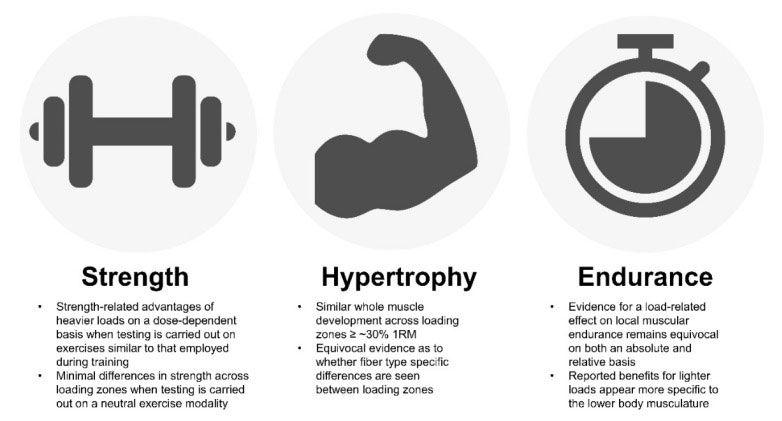
"Summary of current evidence on load-specific adaptations from resistance training." by Brad Schoenfeld et al. is licensed under CC BY 4.0 Progressive Overload
This is the principle of gradually increasing the intensity, weight, or volume over time to allow adaptations to occur. In order to minimize the risk of injury, these progressions should be slow and planned out, typically exceeding no more than a 5-10% increase in intensity, weight, or volume each week. A good rule of thumb for knowing when to increase the weight you are lifting is the 2-for-2 rule. This rule states that if you can perform two extra repetitions on the final two sets of an exercise with perfect form, then weight should be progressed.
- Power
-
Muscular power refers to the ability to exert greater force production over a short period of time. These can be thought of as explosive movements such as a sprint, vertical jump, or olympic lifts like the power-clean and snatch. To train for power, you must emphasize workouts that recruit type II fast-twitch muscle fibers. Plyometric workouts such as box jumps, jump-lunges, and power-skips are great ways to build power in the lower-body muscles. When lifting weights to optimize power, it is best to lower the weight and emphasize a higher speed of movement.
- Cardiorespiratory Endurance
-
There are a plethora of activities you can utilize to improve your endurance. Whether it be through running, biking, hiking, or swimming: it is important to make sure your heart rate and breathing rate are increasing to see meaningful results. Similar to the progressive overload principle for strength training, slow and gradual progressions must be made to endurance training in order to make gains in performance. You should not progress time or distance more than 10-20% each week. This is especially important for those early in their physical fitness training because endurance training places a great deal of stress on the heart. When beginning a training program, it is best to start slow and gradually work your way up. The exercise should feel challenging, but not push you to absolute exhaustion.
- Flexibility
-
To increase flexibility, it is absolutely essential to stretch before and after exercise. Before a workout, it is best to perform dynamic stretches where the muscle is moved through a full range of motion. Some examples of these are trunk twists, leg swings, and walking lunges, or even simply bouncing or jogging in place. After a workout, it is best to perform static stretches, where the muscle is held in place for an extended period of time. These types of stretches should be performed for up to 60 seconds, but should not reach the level of being overly painful. In addition to these stretches, there are forms of exercise such as Pilates and yoga that work to increase flexibility, while also strengthening the muscles.
- Body Composition
-
Basal Metabolic Rate
Often referred to as resting metabolic rate, this number represents the amount of calories the body burns from merely existing over the course of a single day. This number does not take into account any amount of physical activity performed, meaning this is the number of calories burned if you simply layed in bed and did not move at all throughout the day. You must consume this amount of calories each day to maintain your life-sustaining functions.
Total Daily Energy Expenditure
This number represents the total number of calories burned in a single day. It is made up of the BMR, the number of calories burned from physical activity, as well as the thermic effect of food, which is the number of calories burned in the process of metabolizing the food you eat. This number is the benchmark for the number of calories you must consume to gain or lose weight. To lose weight, you should aim to consume around 500 fewer calories per day than this number. In order to gain weight, you should aim for 250-500 more calories per day than this number.
Huberman Lab: How to build a training program to fit your needs
Rest/Recovery
A common misconception about fitness is that adaptations are made during the actual act of exercising. These changes come about in the time following exercise, when the body is in recovery. Exercise places a great deal of stress on the body and knocks it out of homeostasis, which is the state of balance within the body. Proper recovery is essential to return the body to a physiological state of homeostasis and ensure adaptations are made and allow the body to continue exercising. There are a multitude of factors that influence recovery and they all influence one another.
Stretching
After a workout, it is best to use static stretches as a form of recovery. These are stretches that are held in place, usually between 10-60 seconds. These differ from dynamic stretches where the joint is moved through a full range of motion as these stretches are best performed before a workout. Performing static stretches after a workout helps the constricted muscles return to a relaxed state and shuttle lactic acid out of the muscles, which helps decrease soreness.
Active Recovery vs. Rest
Following a session of exercise, there are two main types of recovery that can be performed. The first one is active recovery, which involves performing low-intensity exercises to help the body return to a state of homeostasis. The second type is passive recovery or rest, which is where no activity is performed. Both types should be utilized in order to maximize the recovery process and allow the body to adapt to the exercise. A good example of passive recovery is sleep, which is arguably the most important factor in maximizing recovery. Sleep is when many of the body’s processes are hard at work, and it is crucial to get between 7-9 hours each night. A proper example of active recovery would be walking a few laps following a sprint workout. This allows the body to clear lactic acid from the muscles and gradually return the breathing rate back to its normal state.
Learn About Different Types of Physical Activity
Ways to be Physically Active
- Strength Training
-
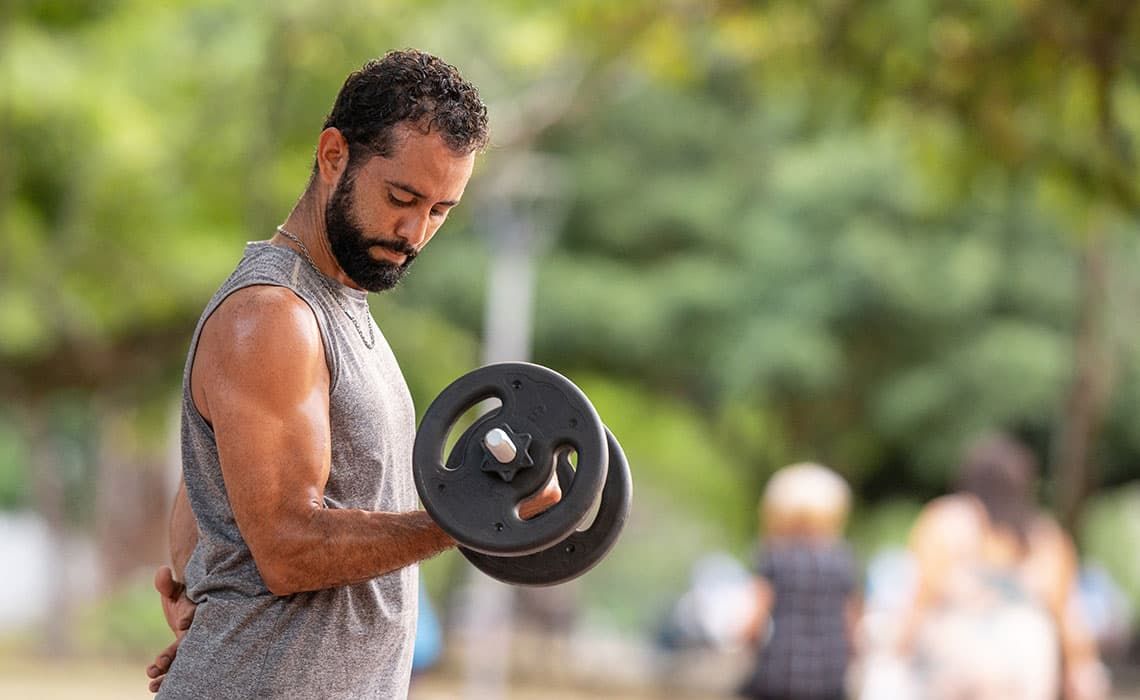
What is it?
Strength training is a subtype of exercise during which an individual produces a movement or exerts a resistance against some form of an opposing force. This opposing force or weight can be one’s own body, as seen with calisthenics such as push-ups and pull-ups where an individual pushes or lifts his or her own body weight against gravity. The opposing force can also be an external weight in the form of a resistance machine, dumbbell, or other piece of weightlifting equipment. People typically participate in strength training with a variety of goals in mind, often while pursuing one or more of the benefits listed in the section below.
Benefits
Strength training is associated with a variety of benefits, including a reduction in anxiety, better body weight management, improved blood sugar control, and better fall prevention just to name a few. A recent review of research studies also found that men and women who undertake any amount of strength training were 15% less likely to die prematurely when compared to individuals who do not lift weights. Review the attached Washington Post article below for more information about strength training benefits and links to some studies highlighting these benefits. The attached Washington Post article below also provides a list of six exercises using common equipment available at almost all gyms that can be a great starting point for someone who is interested in starting a strength training regimen. Jump ahead to the “Getting Started” section of the weight training section to discover more strategies on how to begin your strength training journey.
Six strength training exercises for beginners of any age - Washington Post
It is no surprise, too, strength training increases our confidence. Being able to perform strength training exercises with ease helps boost motivation.
Getting Started
Check out the Working with a Personal Trainer section on this website. For anyone who is new to strength training, it is recommended that you work with a personal trainer before lifting on your own. A personal trainer can assist you in developing an effective strength training program based on your individualized goals and limitations, while simultaneously teaching you proper form and how to carry out various weightlifting movements safely and successfully. Personal trainers can also be a great source of motivation and encouragement, as well as expertise for those who may already know the basics of lifting weights but who want to improve and learn more.
Weight lifting can be intimidating at first. Even though there are many different types of lifting and difficulty levels associated with weight training, research shows that most if not all methods result in an individual making improvements in strength and muscle mass, especially when compared to no exercise at all. Furthermore, studies suggest that lifting light weights can be just as effective for building strength and muscle as lifting heavy weights as long as you lift the light weights to reach fatigue. One does not have to lift the maximum weight they are capable of lifting in order to make significant gains. Read the attached Washington Post article and research review below for more information.
- Lifting light weights is as good as a heavy weight workout - Washington Post
- Resistance training prescription for muscle strength and hypertrophy in healthy adults - British Journal of Sports Medicine
For individuals who have experience lifting weights and are looking to expand upon their existing weight training regimen, below is an excellent video created by Jeff Cavaliere MSPT, CSCS. The video outlines a beginner weight training program for building muscle and strength, organized by functional movement patterns that target major muscle groups. The program is designed to give you a strong foundation in technique first, after which you can then progress to more complicated and difficult exercises within a movement pattern group as you become more advanced to build further strength.
- The PERFECT Beginner Workout (Sets and Reps Included) - Video
- Strength Training Anatomy: Fourth Edition by Frederic Delavier. This book is a great resource for beginners and experts alike. It provides detailed visuals pertaining to the anatomy involved in specific exercises, explanations on how to perform exercises with proper form, and recommendations for strength training in general.
- High-Intensity Interval Training (HIIT)
-

What is it?
HIIT stands for High-Intensity Interval Training. It is a form of exercise that involves alternating between intense bursts of physical activity and short periods of rest or lower-intensity exercise. HIIT workouts are designed to maximize cardiovascular fitness, and improve overall endurance in a shorter amount of time compared to traditional steady-state exercises.
During a HIIT session, you typically perform exercises at near-maximum effort for a specific duration, such as 20 to 60 seconds, followed by a brief rest period of 10 to 30 seconds. This cycle is repeated for several rounds, usually totaling around 15 to 30 minutes.
It's worth noting that HIIT workouts can be intense and may not be suitable for everyone. It's important to consider your fitness level and any underlying health conditions before starting HIIT. If you're a beginner, it's advisable to start slowly, gradually increase intensity, and seek guidance from a qualified fitness professional to ensure proper form and safety.
Benefits
The high-intensity intervals push your heart rate up, while the rest intervals allow for recovery. This dynamic alternation challenges the cardiovascular system and helps improve aerobic and anaerobic fitness, metabolism, and fat burning. HIIT workouts can be done with various exercises, including bodyweight movements, cardio exercises like sprinting or cycling, or using equipment like kettlebells or dumbbells.
- How to get started: A 19-Minute HIIT Workout for Beginners - The New York Times
- Walking
-
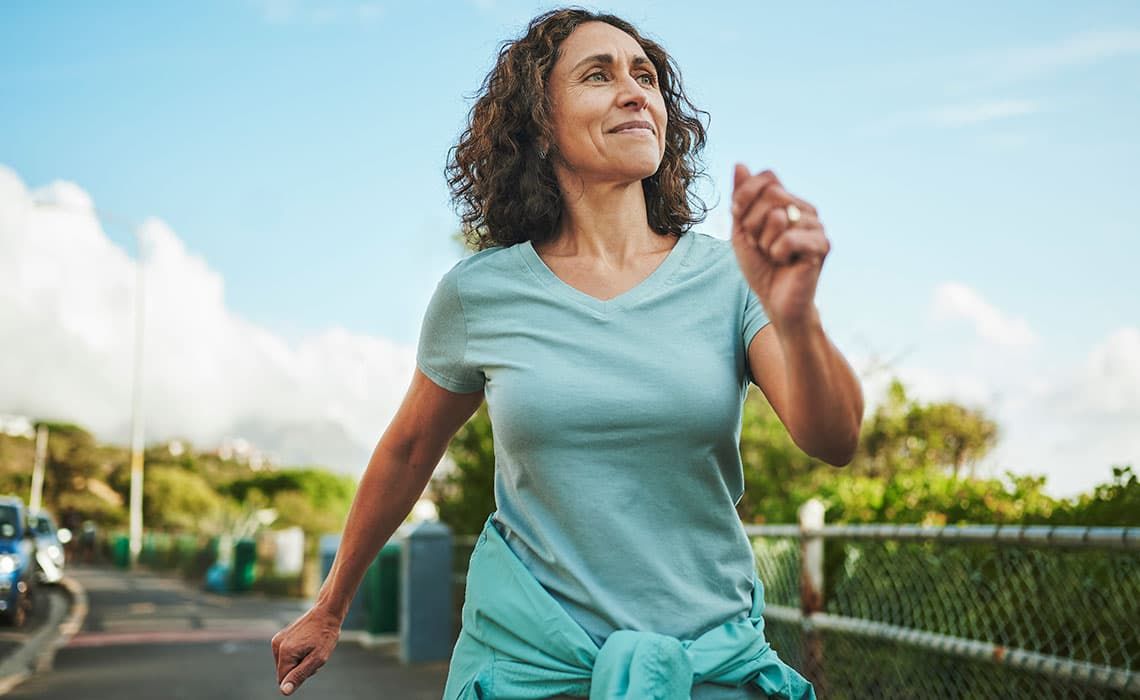
Our bodies are built to move and be physically active. Walking is something we do every day and it is vital to our overall health. Walking can get us outside, connect us with nature and friends and gets us through our daily activities. Walking can be fun and relaxing and reduce stress. Did you know it is also associated with decreased mortality? Any walking or movement is good but to really decrease mortality risk the number of steps a day matters.
Association of Daily Step Count and Step Intensity With Mortality Among US Adults
Maximum mortality benefit is reached at about 10K-12K steps a day but the biggest decrease in risk occurs when going from 2K steps a day to 4K. Start by measuring you steps with the counter in your phone and challenge yourself to increase it by 2000 steps a day and reap the benefits.
- Bodyweight Exercises
-
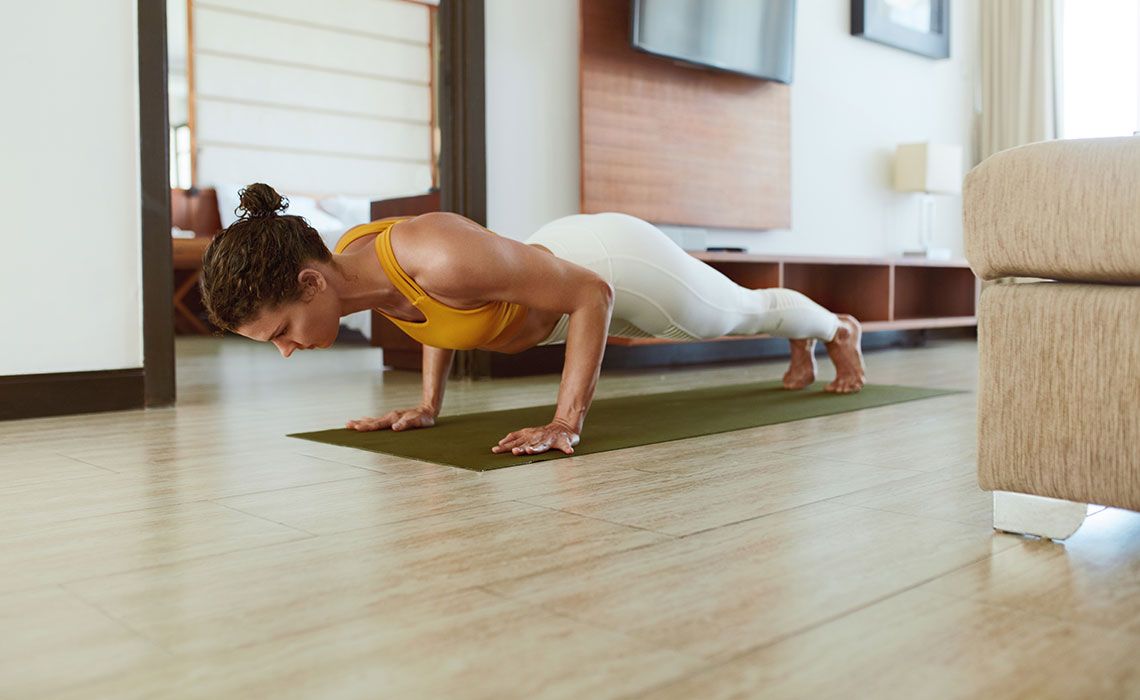
What is it?
They are resistance exercises where resistance is applied by the user's body weight rather than an external force, like a weight in their hand. This is a great form of exercise for those who are just beginning their physical fitness journey or for anyone who does have easy access to a gym or free weights. Examples of bodyweight exercises include pushups, air-squats, lunges, pull-ups, and planks among countless others.
Benefits
Bodyweight workouts tend to feel easier to perform and don’t require the skill and coordination needed to perform workouts with free weights or other equipment making them great for beginners. Perhaps the biggest draw to these types of exercises is that there is no equipment needed, so they can be done wherever and whenever. This is a great way to get in a workout for those who can’t afford or can’t make time to go to a physical gym. These exercises can increase muscle size, strength, muscular endurance, and can be a great high-intensity interval workout (HIIT).
Getting Started
Since bodyweight workouts don’t require any external equipment, they are convenient and can be done anyplace and any time. It is best to start slow and make sure the movements are being done correctly, then working your way up to higher rep ranges. To make workouts more difficult, do them more slowly or hold in in a contracted position to increase time-under-tension. This is a great way to support muscle growth without having to constantly increase the amount of repetitions being performed. These workouts should be done to failure or close to it in order to achieve optimal results.

Book Recommendation:
Bodyweight Strength Training Anatomy by Bret ContrerasIncrease strength, build mass, burn fat, and define your muscles. With full-color anatomical illustrations, step-by-step instructions, and training advice, Bodyweight Strength Training Anatomy is the authoritative resource for sculpting your physique without free weights, machines, or expensive equipment.
Let your body be the gym with Bodyweight Strength Training Anatomy
- Hiking / Rucking
-
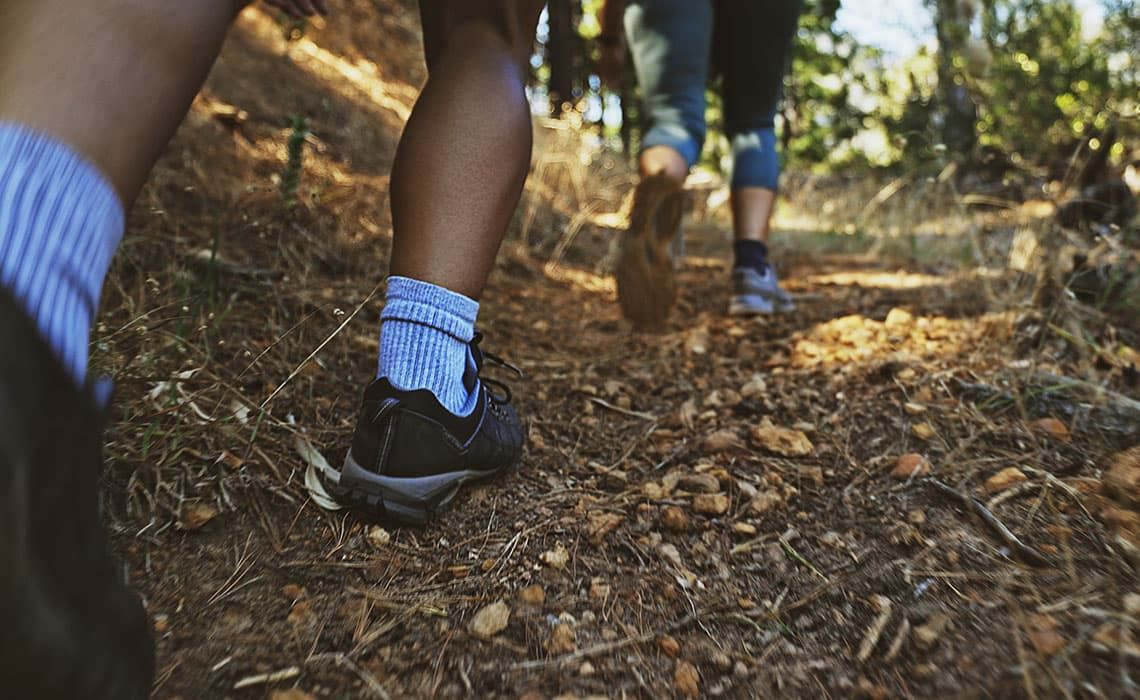
What is it?
Hiking is defined as a long, vigorous walk that is typically done in the countryside or woods. It often involves significant changes in elevation, but that is not a prerequisite to be considered hiking. Rucking is the act of walking or hiking while carrying a weighted backpack or “rucksack”. This is a staple of military training in many countries across the globe and is a fantastic way to add another level of difficulty to a hike.
Benefits
Hiking is a great way for a sedentary individual to get started being physically active because it requires no training or skill. It is also an activity that you can easily start small with shorter hikes and progressively work your way up to longer and more strenuous ones. There are also serious benefits to mental health from spending time in nature. It has been shown to reduce stress and lead to lower levels of depression.
Getting Started
Alltrails.com is a wonderful resource to find trails in your area. For those in the Washington, D.C. area, Rock Creek Park and Great Falls are fantastic places within the metro area to hike and get into secluded nature. If you are willing to drive a bit, Shenandoah National Park is about 1.5 hours from D.C. and contains over 500 miles of hiking trails with breathtaking views of the Shenandoah Valley.
- Running
-
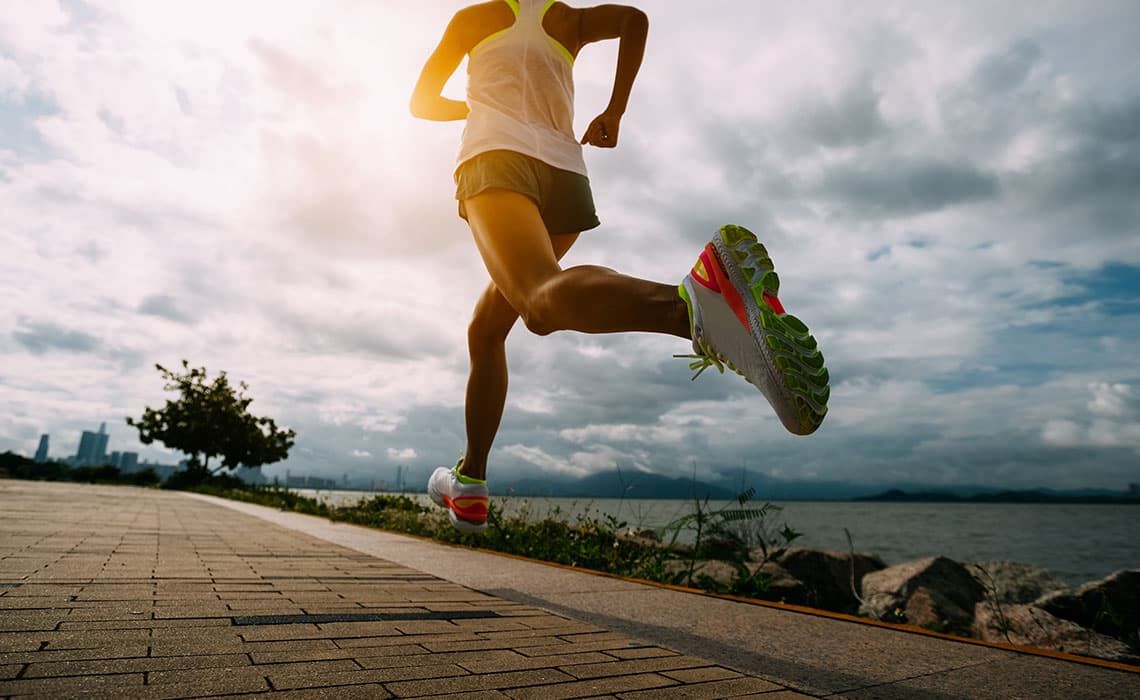
What is it?
Running is a type of aerobic exercise. While running primarily targets the leg muscles, core muscles, heart and lungs, it ultimately has a positive impact on the entire body, producing both physical and mental benefits. Keep reading to learn more about the benefits associated with running.
Benefits;
Many experts believe that humans are shaped the way they are because we evolved to be endurance runners. Therefore, it makes sense why our bodies reward us with a multitude of benefits by doing what we were designed to do as humans: run.
Below are more articles that discuss why running is incredibly valuable to the health of those individuals who choose to partake.
- The Truth Behind ‘Runners High’ and Other Mental Benefits of Running
- Running for health: Even a little bit is good, but a little more is probably better
A 2013 study in Denmark (linked in the above article) inferred that up to 2.5 hours of running a week is ideal if you want to maximize longevity outcomes.
Getting Started
As with many types of physical activity, it is never too late to get started! A New York Times article provides a great overview on running as well as a framework for how someone can become a runner.
For those individuals who want to run with other people, the Washingtonian Magazine has compiled a list of running clubs in the greater Washington D.C. area.
- Biking (Cycling, Mountain Biking, BMX, etc.)
-

What is it?
Riding a bicycle is a common activity all over the globe. Whether it be for getting from place-to-place, exercising, or going for a thrill-seeking ride down steep mountain trails, there is no denying that people simply love riding bikes. If you are a sedentary person who is looking to increase your level of physical activity, biking is a fantastic way to get started that is fun, allows you to get outside, and easier on the joints than other methods of exercise. Riding bikes comes in multiple different forms with a vast range of benefits and potential detriments.
- Mountain Biking: Riding on trails made of dirt or gravel that often is done in the mountains with a great deal of downhill riding.
- Road Biking (Cycling): The act of riding on roads, often in large groups of other cyclists. This is the type of biking you see in big-name races such as the Tour de France.
- Hybrid: These bikes are typically used for more leisurely styles of riding or as a means of commuting. While they are not normally used for intense exercise, a ride at a leisurely pace can still offer physical and mental benefits.
Benefits
Biking is a fantastic way to build cardiovascular fitness without placing a great deal of stress on the joints. While running is another popular and easy way to build fitness, it is high-impact and places a lot of stress on the joints and muscles, which can lead to an increased risk of injury. Due to the low-impact nature of cycling, it is easier to ramp up the miles and burn more calories due to needing less recovery time.
Getting Started
Perhaps the biggest drawback to biking is that it requires money to be spent on a bicycle. High-end mountain bikes and road bikes can end up costing thousands of dollars, although cheaper alternatives certainly do exist. The REI website has a helpful page on selecting the right bike for you based on experience level and the type of biking you plan on doing. Once you have purchased a bike, there are a number of useful websites such as traillink.com that can help you find nearby trails. For those in the Washington, D.C. area, the Mount Vernon Trail, Capital Crescent Trail, and Metropolitan Branch Trail are all fantastic options that are easily accessible from the city’s core. There are also multiple groups such as r/bikedc on Reddit and DC Bike Party that organize group rides in the area.
- Yoga
-
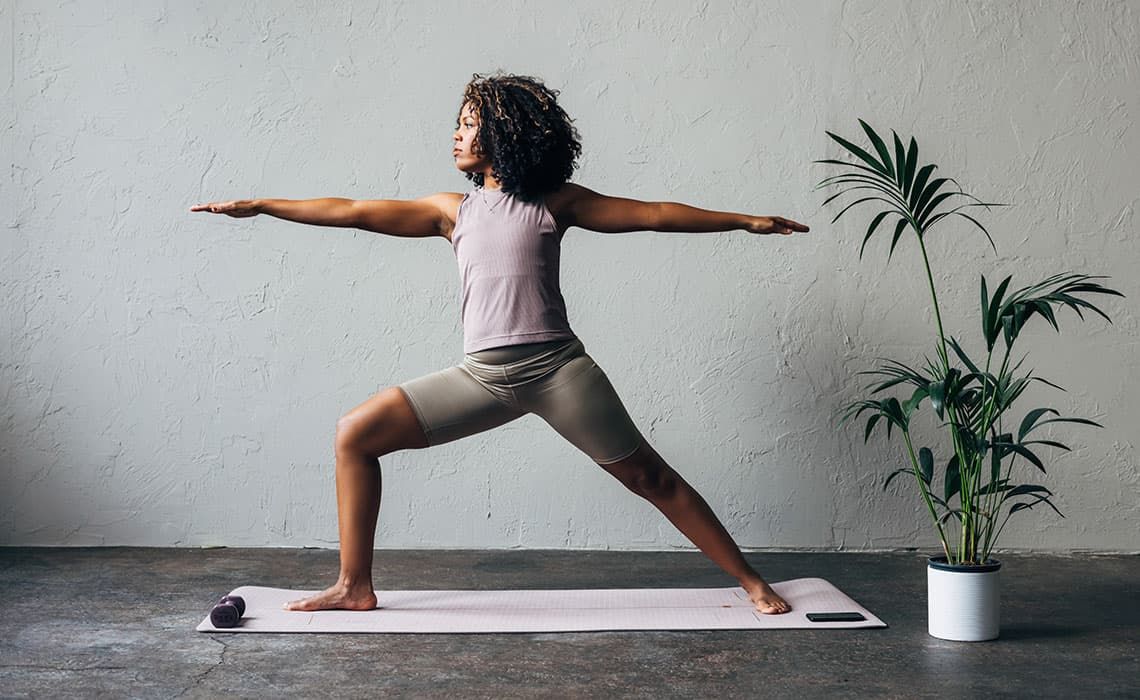
What is it?
Yoga is a holistic practice that combines physical postures, breath control, and meditation to promote overall well-being. It helps improve flexibility, strength, and mental focus.
Benefits
Yoga offers numerous health benefits for both the body and mind. Some specific benefits include:
- Increased flexibility: Regular practice of yoga can improve flexibility and joint range of motion, making daily movements easier and reducing the risk of injuries.
- Improved strength and muscle tone: Yoga poses require you to engage and strengthen various muscle groups, leading to improved overall strength and toned muscles.
- Better posture: Yoga helps promote proper alignment and strengthens the muscles responsible for maintaining good posture. This can alleviate common issues like back and neck pain.
- Enhanced balance and stability: Yoga poses often involve balance, which can improve stability and coordination. This is especially beneficial for older adults in reducing the risk of falls.
- Stress reduction: The combination of physical movement, deep breathing, and mindfulness in yoga can reduce stress levels and promote relaxation. It may also help lower cortisol (stress hormone) levels in the body.
- Increased mindfulness and mental focus: Yoga incorporates meditation and breath control, which can enhance mindfulness and improve mental clarity, concentration, and overall cognitive function.
- Improved sleep quality: Regular yoga practice has been associated with better sleep. The relaxation techniques and stress reduction benefits of yoga can help promote a restful night's sleep.
- Boosted mood and emotional well-being: Yoga's mind-body connection can have a positive impact on mental health. It may help reduce symptoms of anxiety, depression, and improve overall mood and emotional well-being.
It's important to note that individual experiences may vary, and it's always advisable to consult with a healthcare professional before starting any new exercise or wellness regimen.
Getting Started
Interested in trying yoga? Get started with these steps:
- Find a suitable yoga style: Research and choose a style that resonates with you, such as Hatha, Vinyasa, or Yin yoga. Each style has its own pace and emphasis.
- Begin with basic poses: Start with simple poses like Mountain Pose, Child's Pose, and Downward Dog. These foundational poses will help you build strength and flexibility gradually.
- Follow guided classes: Join beginner-friendly yoga classes, either in-person or online, led by experienced instructors. They will guide you through proper alignment and provide modifications if needed.
- Practice regularly: Consistency is key. Aim for a regular practice, even if it's just a few minutes each day. As you progress, gradually increase the duration and intensity of your sessions.
- Listen to your body: Pay attention to how your body feels during each pose. Never force yourself into a position that causes pain or discomfort. Honor your limits and progress at your own pace.
- Incorporate breathwork and meditation: Learn basic breathing techniques and explore meditation to enhance the mind-body connection. These practices can help reduce stress and promote relaxation.
- Seek guidance when needed: If you have any specific health concerns or limitations, consult with a qualified yoga instructor or healthcare professional for personalized guidance.
Remember, yoga is a journey of self-discovery and self-care. Enjoy the process and be patient with yourself as you explore this ancient practice.
Get started here: Yoga with Adriene (YouTube)
"Our mission is to connect as many people as possible through high-quality free yoga videos. We welcome all levels, all bodies, all genders, all souls! If you're brand-new to yoga, check out my Yoga For Beginners and Foundations of Yoga series. These are designed to give you the tools to build a happy, healthy at-home yoga practice. Do your best, be authentic, and FIND WHAT FEELS GOOD. Jump on in! You don't even have to leave your house."
- Team Sports and Racket Sports
-

What is it?
There are numerous types of sports enjoyed by children and adults throughout the world. Some have been around for thousands of years, while others have only come into existence very recently. Many sports are unique in that they often transcend language and culture barriers, uniting people from a variety of backgrounds through a shared passion for the game being played. While certain sports are incredibly demanding physically, others can be played well into the later years of life, meaning that it is never too early or too late to become or continue to be an athlete. Sports are arguably the most enjoyable and dynamic type of physical activity available and can be incredibly rewarding to those involved. Find what sport(s) may be right for you and enjoy the wide array of benefits from getting active!
Benefits
Engaging in sports is a great way to train one’s proprioception, meaning one’s ability to perceive the location, movements, and action of parts of the body. In many sports, people need to react to a ball, the action of an opponent, and/or other factors that result in training muscle strength and endurance in a less static, more dynamic manner when compared to other forms of physical activity such as stationary biking. Furthermore, sports have the added benefit of providing an individual with a social outlet, allowing people to form friendships through exercise and competition. Sports can be a great complement to other types of physical activity in an individual’s comprehensive exercise regimen.
Getting Started
- Be realistic.
- What sports are you capable of doing physically and safely? If you have any concerns about health risks from participating in sports, speak with a qualified medical professional before getting started.
- What sports are an option in your geographic location?
- What sports can you realistically fit into your schedule?
- What sports can you afford to partake in financially?
- Decide what sport(s) you want to participate in.
- Determine what level of commitment you are looking for (organized team, casual pick-up games, etc.).
- Think about what intensity level you are pursuing (looking to challenge oneself and play at a highly competitive level, just playing for fun, etc.)
- Identify what you are trying to get out of the sport(s) you choose (fun, fitness, stress-relief, camaraderie, etc.)
- Get started! Search online for courts, fields, sports leagues, and other resources available in your local community. Below is a link to an organization called Volo Sports that created recreational sports leagues in Washington D.C.
Volo Sports offers adult leagues for 12 different sports, as well as options to sign up for pick-up games to play some of these sports casually without having to be on an official team.
- Be realistic.
- Dancing
-
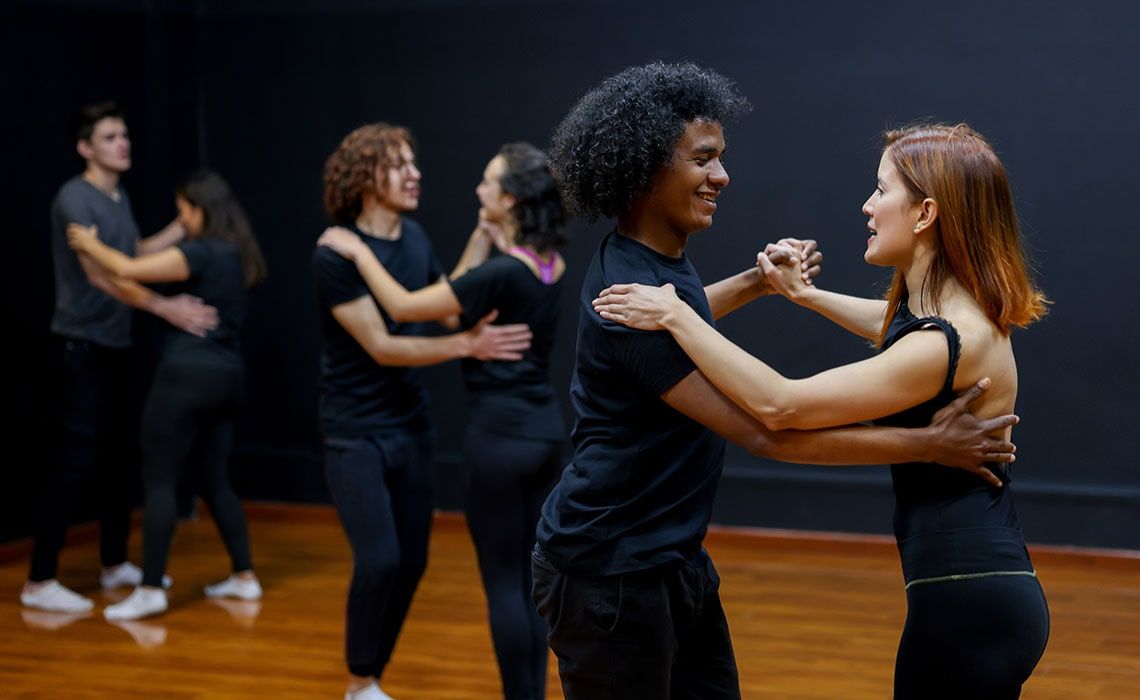
What is it?
Dancing is defined as the movement of the body in a rhythmic way, usually to music and to express an idea or emotion. It can come in the form of a structured dance class, break dancing, or going to a concert and letting loose. There are essentially no barriers to this activity and while you can certainly practice to improve your moves, there is no minimum skill level needed to start.
Benefits
Dancing has a number of physical as well as psychological benefits. It is a great way to burn a lot of calories if it is performed with intensity and for a long period of time. Depending on the type of dance, it can also be useful for training balance and agility. What separates dance from other forms of physical activity are the countless psychological benefits to be gained from engaging in it. Studies have shown that dance has the ability to alleviate depressive symptoms, increase self-confidence, and improve executive function. Dancing is also usually accompanied with listening to music, which has been shown to reduce anxiety, improve sleep quality, and memory.
Getting Started
Dance is perhaps one of the easiest forms of physical activity to get started with as you can simply just start doing it at home whenever you feel like it. However, if you are craving more structure, there are a number of dance classes available in the D.C. area offering a wide variety of styles and skill levels. Attending concerts is also a fantastic way to go somewhere to dance in a judgment-free environment.
- Pilates & Exercise Classes
-
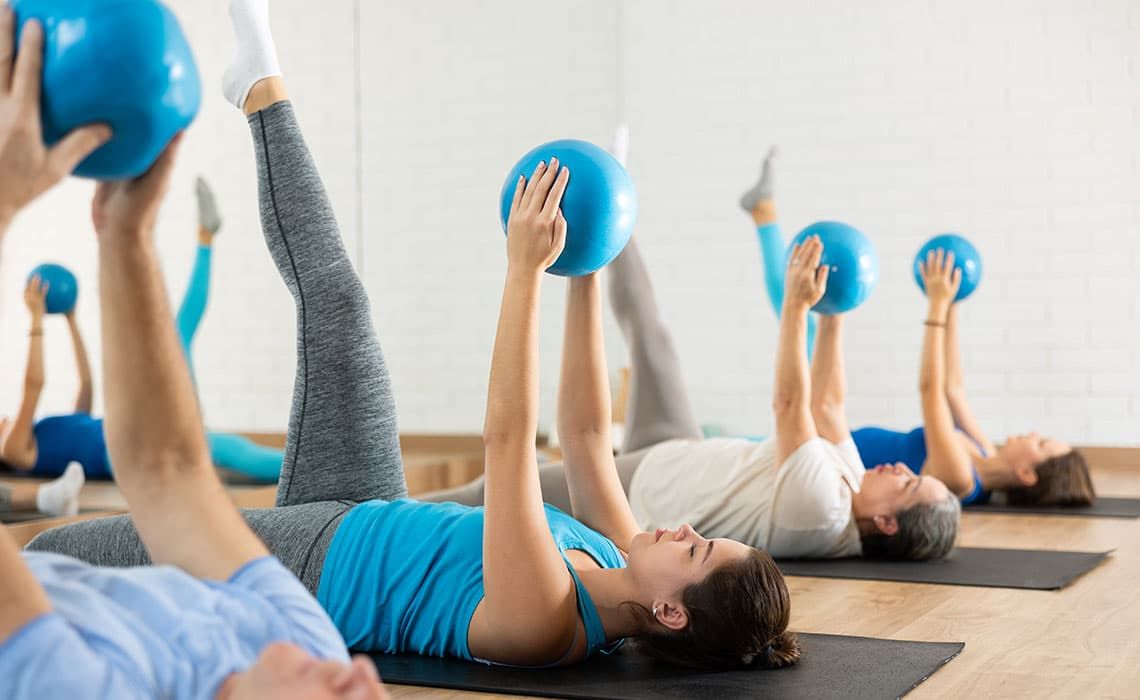
What is it?
Group exercise classes are done in a community setting with an instructor leading the class. They can vary greatly in their intensity and type of exercise. Yoga classes count, but there are many other types as well such as Solidcore and Soulcycle.
Benefits
Besides the obvious physical benefits to be gained from exercise, group exercise classes include various mental health benefits due to their social nature. There is data to suggest that physical activity that includes social connection improves satisfaction and users are more likely to continue engaging in the activity. These classes can be more fun for new exercisers and can offer a support network to encourage each other and promote physical improvement.
Getting Started
There are various types of exercise classes for different fitness levels and physical activity interests. It is best to find a class that you think will be enjoyable as that makes it much more likely for you to stick with it. One drawback is that these exercise classes can often be quite expensive. George Washington University offers summer exercise classes that are affordable with a $10 drop in fee for a single class.
- Combat sports (Boxing, Brazilian Jiu-Jitsu, Karate, Wrestling)
-

What is it?
Combat sports is an umbrella term that refers to various styles of fighting techniques such as boxing, Brazilian jiu-jitsu, wrestling, Muay Thai, and other disciplines. If multiple of these fighting disciplines, which are also known as “martial arts,” are incorporated into one training program in which more than one style is utilized, a person is said to be practicing “mixed martial arts.” An example of a mixed martial artist would be someone who trains in kickboxing, wrestling, and karate.
Benefits
- Improved confidence in one’s ability to enact self-defense
- Improved strength and conditioning, given that training in combat sports requires strength to perform various fighting techniques and stamina to be able to prolong fatigue onset while performing these techniques
- Camaraderie with fellow gym members: the intense training associated with combat sports often results in tight bonds forming between practitioners of the sport
Getting Started
Decide which category you fall into:
- Are you looking to practice a combat sport as a hobby for exercise only (i.e. a boxing class that hits heavy bags and performs other exercises, but that does not involve any striking of other classmates)
- Are you looking to practice a combat sport with the goal of eventually competing (i.e. joining a Brazilian jiu-jitsu gym and actively competing against other classmates, acknowledging the risk of possible injury)
After you decide whether you are pursuing combat sports as a hobby/solely exercise vs. with a plan to train competitively, research local gyms to:
- Research gym prices (combat sports classes/memberships can be very expensive): seek out free trials at gyms of interest before signing up
- Learn about the classes/training a gym offers
- Learn about a gym of interest’s culture (level of competitiveness among gym’s practitioners, injury risk associated with fighting discipline and safety measures taken at gym)
- Gardening
-

What is it?
Gardening is defined as the growing and cultivating of plants as part of horticulture, meaning in gardens or greenhouses as opposed to field-scale production. This activity can range from growing various flowers and plants for decorative purposes or growing fruits and vegetables to be consumed.
Benefits
While gardening is certainly far removed from being vigorous exercise, it can offer many physical benefits, especially for those of older age groups. Gardening offers muscle strengthening activities in the form of functional movements such as squats and lunges when planting something in the ground. Lifting heavy things such as bags of mulch can often be a part of gardening. There is even an exercise named after this act called farmers carries, where the individual will hold two heavy weights in each hand and walk for as long as possible. Activities such as digging, raking, and pushing a lawn-mower can work the cardiovascular system by increasing heart rate and can also build muscular endurance by repeating movements for long durations of time. In addition to these benefits to physical fitness, there are mental benefits as well. Spending time outside has been proven to decrease stress levels and sunlight can increase levels of vitamin D. There can also be nutritional benefits to gardening if you are growing your own fruits and vegetables.
Getting Started
Obviously, in order to begin gardening at home, you must have a house with ample outdoor space provided to actually garden on. For those who live in apartment buildings or anywhere without their own outdoor space, community gardens are a great way to reap the physical benefits of gardening, while also building social connections and providing a needed service to your community. If you live within D.C., the Department of Parks and Recreation has a website with lists of various community gardens all throughout the city in need of volunteers.
- Jump Rope
-
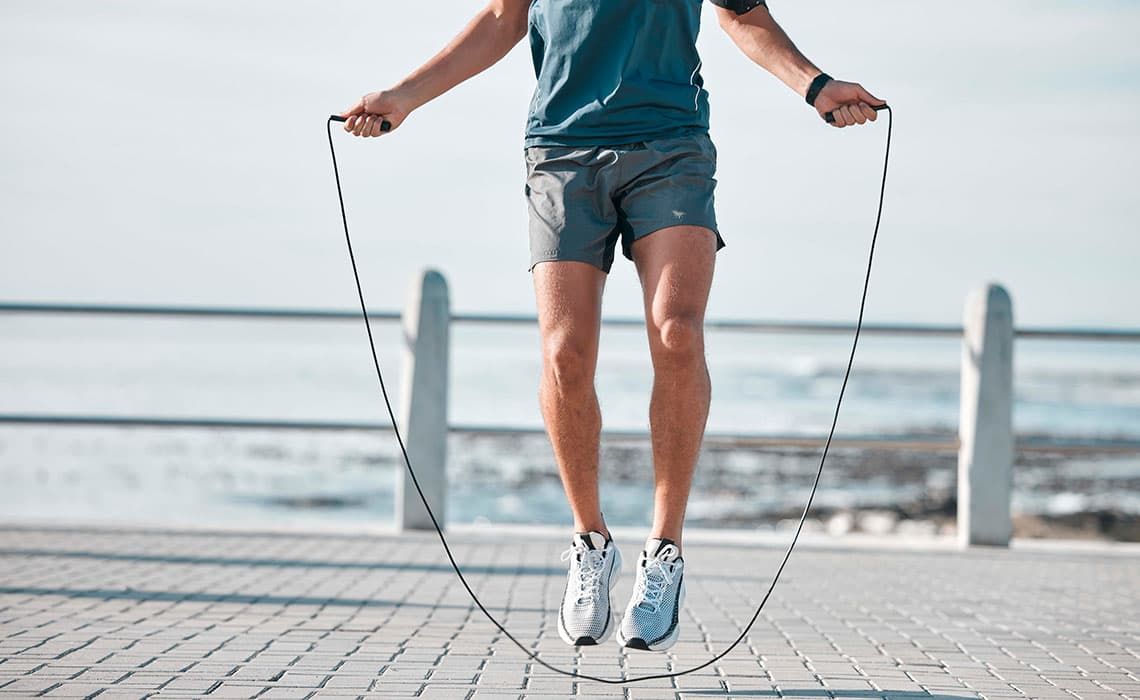
What is it?
Jumping rope is a popular activity where a rope is used for jumping by swinging it over the head and under the feet. It is a common leisure activity for little kids, but can also be used as a fantastic form of exercise that is easy to learn, accessible, and great for burning calories.
Benefits
Jumping rope is a versatile exercise that can be used as an excellent warm-up or as an entire workout on its own. It is useful for burning calories, improving hand-eye coordination, and increasing bone-density. While jumping rope can be done at a slow pace and used as a form of steady-state cardio, you can also up the intensity and use it as a method of high-intensity interval training (HIIT).
Getting Started
All that is needed to perform this exercise is a jump-rope of adequate length for your body size. When beginning, it may take some time to get the timing and coordination down. However, once you master the basics, there are many ways to up the difficulty level such as high-knees or double-unders. To measure your improvement, you can try to go for longer durations of time at a higher intensity.
- Plyometrics
-
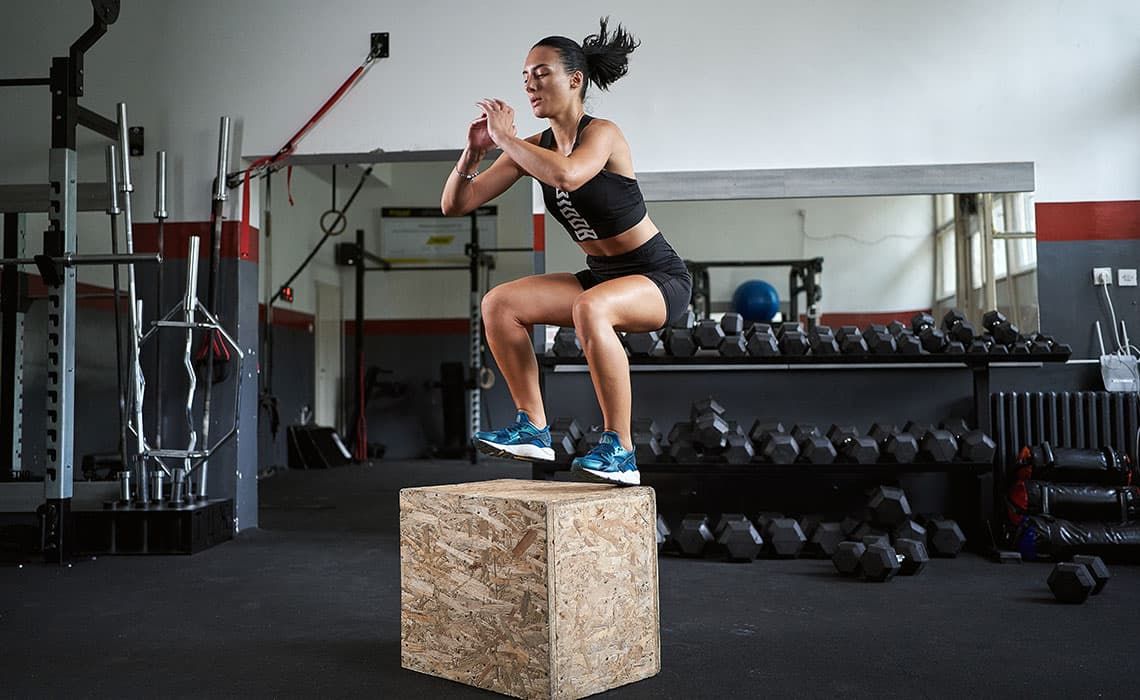
What is it?
Plyometrics, also known as jump-training, are explosive exercises in which the muscles exert maximum force in short-bursts to increase power. This type of training is often used by athletes to improve the activation of fast-twitch muscle fibers, but has many applications outside of sports. Some examples of plyometric training include box-jumps, power-skipping, and broad jumps.
Benefits
Perhaps the greatest benefit of plyometrics for the average person is that they are very easy to perform and most methods involve little to no equipment. These exercises are great for increasing power and jumping ability, which are very important attributes in many sports. There is also great variability in how they are performed. If you want to use plyometrics to train for endurance, you can increase the number of repetitions performed until close to failure. Plyometrics can also be utilized as a great warm-up before a training session.
Getting Started
Many forms such as power-skipping, lunge-jumps, and squat jumps require no prior experience and can easily be started wherever and whenever. They can be done prior to an intense training session, or while watching tv as an easy way to get a quick bout of exercise in. Some forms, such as box jumps, require a box or platform to jump on, but those can be found at most gyms and even sometimes in local parks. Over time, you can increase the volume of work being performed or in the case of box jumps, increase the height of the box. Just be sure to practice proper form and ensure safe landings are being performed as that is when you are most susceptible to injury.
Plyometrics: Developing Power With Plyometric Exercises - NASM
